


































Publication: Norfolk Farms Darin V2 Ken Client: BASF File Name: Serifel_2024_MIX VEG_Print_NF-Banner_v2 Enjoy the versatility of use in multiple crops, with conventional chemistry or in organic production. GANG UP ON DISEASE. Learn more at agsolutions.ca/horticulture Always read and follow label directions. AgSolutions and SERIFEL are registered trademarks of BASF, used under license by BASF Canada Inc. © 2024 BASF 3217-2_Serifel_2024_MIX VEG_Print_NF-Banner_v2.indd 1 2024-01-04 12:01 PM TOUCH A TRUCK A8 A16 A HANDFUL OF JOY SECTION A / ISSUE 29 / SPRING 2024 30 Norfolk St. S. Simcoe 519-428-9831 •Corporate Investments •TFSAs, RRSPs, RRIFs & LIFs •Annuities, Mortgages •Life, Long Term Care, Critical Illness & Disability Insurance •Pension & Group Benefits Greg Harvey CFP, EPC, RRC Simcoe 519-428-9831 NORFOLK COUNTY - ONTARIO’S GARDEN Call or visit us for a free, no obligation quote. 519-688-3638 230 Lisgar Ave., Unit 7+8, Tillsonburg 519-426-8061 1 Oak St., Simcoe Services available in Ontario through Canada Brokerlink (Ontario) Inc. ™BrokerLink & Design is a trademark of Canada Brokerlink Inc. used under license. Copyright 2021 Canada Brokerlink Inc. All rights reserved. 226-549-0462 • COMMERCIAL • RESIDENTIAL • INDUSTRIAL • AGRICULTURAL Since1987 24 HOUR EMERGENCY SERVICE 226-549-0462 226-549-0462 • COMMERCIAL • RESIDENTIAL • INDUSTRIAL • AGRICULTURAL Since1987 24 HOUR EMERGENCY SERVICE 226-549-0462 226-549-0462 • COMMERCIAL • RESIDENTIAL • INDUSTRIAL • AGRICULTURAL Since1987 24 HOUR EMERGENCY SERVICE 226-549-0462 ECRA # 7000857 226-549-0462 • COMMERCIAL • RESIDENTIAL • INDUSTRIAL • AGRICULTURAL Since1987 24 HOUR EMERGENCY SERVICE 226-549-0462 We Know Dean Morrison (519) 909-0340 Karen Feth (519) 718-3384 Broker of Record Dean Morrison Dean Morrison (519) 909-0340 www.morrisonrealty.ca Experienced with farm sales. We are here to assist you when you sell your farm. 1696 Windham Rd. 9, Windham Centre 519-443-7352 Tyler Townsend CASEY CLEAVER A4 B1 A blooming experience A10











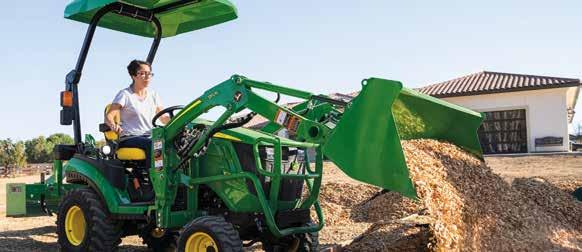





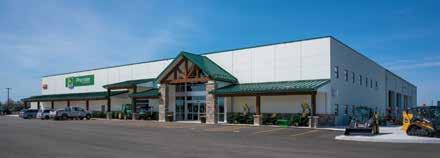

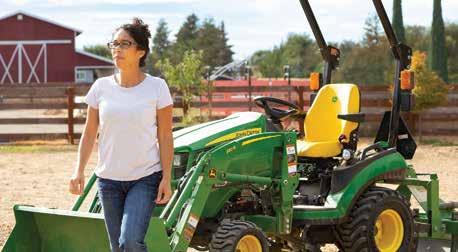
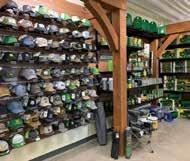




FINANCING STARTING AT 0 % premierequipment.ca on Compact Utility Tractors plus other incentives + offers on Residential Lawn Tractors, Zero Turn Mowers and Gator Utility Vehicles. There is nothing like running a Deere. We could try to put it into words for you. We’d use words like powerful, satisfying and comfortable. But to be honest, the experience says it all. You just have to get in the seat. Stop by your local Premier to try for yourself. Premier Equipment Norwich 265721 Maple Dell Road, Norwich ON Come visit us at our Norwich location! Call (519) 688-1011 or Visit premierequipment.ca TELEHANDLERS ASK US ABOUT AND
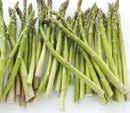
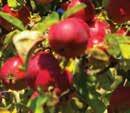
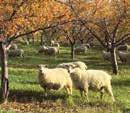
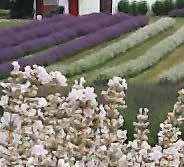
Publisher
Stewart Grant • stew@granthaven.com
Sales
David Douglas – dougls@kwic.com
Graphic Design
Tyler Carruthers • norfolkfarmsnewspaper@gmail.com
Business Development
Heather Dunbar • heather@granthaven.com
Billing Administrator
Jen Gaetan • jen@granthaven.com
36 Water St. St. Marys, ON, PO Box 2310 N4X 1A2 norfolkfarmsnewspaper@gmail.com | 519.868.1290 | norfolkfarmsnews.ca
Restoring small-town journalism, one community at a time!
Horticulture important in Norfolk County
There was a day, not that long ago, when Norfolk County was known as tobacco country.
As the tobacco industry downsized, Norfolk farmers diversified, searching for new crops and niches. Today, a wide diversity of crops are grown, but the emphasis has switched to horticulture. The transformation is to the point that the county now bills itself as Ontario’s Garden.
Norfolk County is the number producer in the province for asparagus, cabbage, tart cherries, ginseng, peppers, pumpkins, rye, squash and zucchini and strawberries. Many other fruits and vegetables are produced in smaller quantities.
Provincially, there are more than 125 different fruits and vegetables grown. Many are cultivated in Norfolk County.
The change wasn’t without its struggles. Farmers who were used to relying on a marketing board to sell their crop had to learn to do their own marketing, retailing, shipping and promotion. One result of the change was the plethora of roadside fruit and vegetable stands found on the county’s roads during the summer and early fall. Locals and tourists can now access produce at its peak of fresh-picked goodness and flavour.
Producing our own food adds to Ontario and Canada’s food security. This was seen first hand during the recent COVID pandemic and fertilizer shortage caused by the Russian-Ukraine war. Norfolk County played a large role in securing local, fresh food when there were restrictions on movement. It also plays into buy local campaigns and the 100-miles diet.
Many farmers that once produced tobacco have retired and the next generation taken over, embracing the niche their forebearers found in horticulture. They haven’t forgotten their past, but are embracing the future and how new technology can make the Norfolk Sand Plain farm even more viable.

NORFOLK FARMS - SPRING 2024 - A3
Editorial
Your hearing helps you stay connected to those who matter most, enjoy all the sights and sounds around you, and maintain a good quality of life. Get your hearing checked by a licensed hearing care professional at your local Connect Hearing clinic. Don’t miss out on the sounds that you love. Check your hearing. Save up to $2,000 on a pair of Select level hearing aids with your CAA membership!* Rewards Book your FREE* hearing test today! 1.888.850.9979 • connecthearing.ca Simcoe: #3 - 138 Queensway 519.426.2288 Tillsonburg: 35 Harvey Street 519.688.0022 VAC, WCB, WSIB, ADP & ODSP accepted. Part of the WorkSafeBC provider network. ®CAA and CAA logo trademarks owned by, and use is authorized by, the Canadian Automobile Association. CAA RewardsTM used by the Canadian Automobile Association. *Hearing evaluations/tests are free for customers over the age of 18. Fees may apply where specific testing for employment purposes, reports, a copy of your results or the completion of an application is required. See clinic for full details. †Based on national physician referrals over the tenure of the corporation’s Canadian business operations compared to the disclosed referral count of leading competitors. Save up to $2,000 on a pair of Select technology level Sonova hearing aids; 15% off Advanced level; and 10% off Standard level with a valid CAA membership. This offer is a tiered rebate determined by which level of Sonova Hearing Technology purchased. Offer expires September 30, 2024. Some conditions apply. See clinic for details. CHCA24_Norfolk Farms_Connect Hearing Ad_10.25x7.25_Spring.indd 1 10/04/2024 8:49:46 AM
NFA president seventh generation Norfolk farmer
Norfolk Federation of Agriculture president Tyler Townsend is the seventh generation of his family to grow the same land.
First elected as president in March 2023, he was re-elected this year and at 37 years old, brings youth to the executive. This was a step up from being vice-president for him, as he was on the board for a few years prior to that.
“Some of the older members that were leaving asked if I would let my name stand,” he recounted as the reason he became president.
As president, he chairs the meeting.
One of the main responsibilities of the Norfolk Federation of Agriculture is to advocate for farmers at the county level. This goes along with the Ontario Federation of Agriculture lobbying for farmers provincially and Canadian Federation of Agriculture nationally.
With reassessment coming to Ontario in the next couple of years, NFA is gearing up to go to bat for farmers when Norfolk County sets the tax rate.
“As farm land, it may be increasing in value but at the end
of the day we aren’t making any more money than we were 20 years ago,” Townsend said. “Our costs have gone up but corn is the same price. I know with beans the margin is as tight as it was before. It doesn’t matter if you milk cows, raise chickens, whatever, the costs have continually gone up. Every time taxes increase on the land, it affects us.”
NFA also reviews request for funding. Generally, NFA supports the Norfolk County Fair’s ag awareness programs and Norfolk General Hospital. One of their more recent initiatives is supporting the soccer tournament that was organized for temporary foreign workers. They are also throwing their support behind the irrigation day coming up that is being organized by Norfolk Soil and Crop Improvement Association.
“I’m the guy that if someone wants something they will call me and I can make sure the secretary gets it in front of the board,” Townsend said.
At 37, Townsend is one of the younger presidents NFA has had. But, he grew up on the farm and

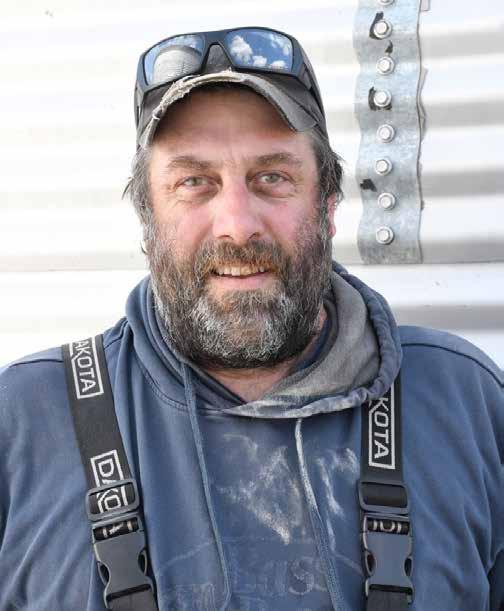
has generations-old farming knowledge.
cause the sheep herd was killed off by wolves,” Townsend said.




The farm he lives on south of Walsingham, was settled by his great-great-great-great grandfather in 1842. His great-great-grandfather, John Wilbur Townsend –known as the Colonel for his rank in the Norfolk Militia, was one of the pioneers in bringing tobacco to Norfolk County. The family understands the farm was the second one in the county with tobacco on it when the first crop was planted in 1927.
The farm was originally used for white beans and at one time was also a sheep farm.
“I know that is one of the reasons my great-great grandfather brought tobacco here was be-
Today, Townsend farms with his parents Bill and Susanna, growing cash crops on 400 to 500 acres. This includes the farm where his father lives across the highway and rented ground.
While on the surface, it might seem like younger blood at the helm of the NFA being a positive step forward as past-president Ted Smith is also younger, Townsend said there are still a lot of older farmers on the executive.
“We try every year but it just seems to be the same people come back. We don’t seem to be able to entice any new faces,” he said, while encouraging others to join the executive.

A4 - NORFOLK FARMS - SPRING 2024
Tyler Townsend is the president of the Norfolk Federation of Agriculture.
WE CARRY LOCALLY PRODUCED APPLES FROM SEPTEMBER TO JUNE STORE IS OPEN SEASONALLY MONDAY - SATURDAY 9AM - 5PM www.nfga.ca/retail 99 Queensway East, Simcoe, Ontario (519) 426-0640 ext. 234 LOCAL PRODUCTS: - baked goods - apple cider donuts - giftware - custom gift baskets, etc.
Shovelling corn in the elevator on a shipping day is one of the duties that keeps NFA president Tyler Townsend busy in the off season.
B and C Farms offers farm-gate meat
In the business world, those who take an unsuccessful company or venture and make it an overwhelming success are often referred to as turnaround artists. This terminology is used rarely in the farming world, but if it was Ben and Carolin Vandenboogaard would certainly be prime candidates.
Operating B and C Farms at 72 McDowell Rd. W., just south of Langton, the couple purchased 50 acres 14 years ago that was in a state of disrepair.
“Every building on here was dilapadated and on the verge of falling down,” Carolin said. “It’s not ideal property for farming. It’s hilly and not rectangular fields, but we saw it for what we wanted – cattle.”
The couple raises their cattle on the farm’s pasture, and sells their beef off the farm. Part of the acreage is rented out for cash crops while the remainder is in pasture and ravines.
The couple has a background in raising livestock. Carolin was raised in Burgessville on a farm where her parents had veal and dairy. Ben grew up on a veal farm near Chatham.
“We started out with Holstein-beef cross cattle,” Carolin said. “We were just outside Tillsonburg and quickly outgrew that property.”
Moving to the larger farm in Norfolk with the dilapidated buildings meant some sacrifices had to be made. The couple lived in the shop for two years while planning for what their farm operation and home would eventually look like. At the time both worked off the farm.
The formula they ended up with for raising cattle is starting with stockers seven or eight months old and raising them to 16 to 20 months when they are ready for the butcher.

TOPNOTCHSERVICE

The cattle are pasture fed and finished on grain to give a nice marbling and structure to the meat. Usually, B and C Farms has 40 to 50 head on the farm in various stages of growth.
“People like we don’t put any hormones in it,” Carolin said. “Our animals aren’t stressed and it give an amazing flavour to our meat.”
The cattle spend the nights in the barn and have food and water in front of them at all times. Carolin said their customers like knowing where the meat comes from, how it’s raised and how the animals are treated.
Then when COVID hit in 2020, B & C Farms shop suddenly got a lot busier, which was amazing, until the butcher shops were too busy, and unable to offer custom processing. This lead them to be shut down for several months as they had no beef to sell. In 2021, they built their own butcher shop and hired a butcher. The following year, Carolin stopped working off the farm.
“It’s been a progression and when one door closes, another opens,” she said.
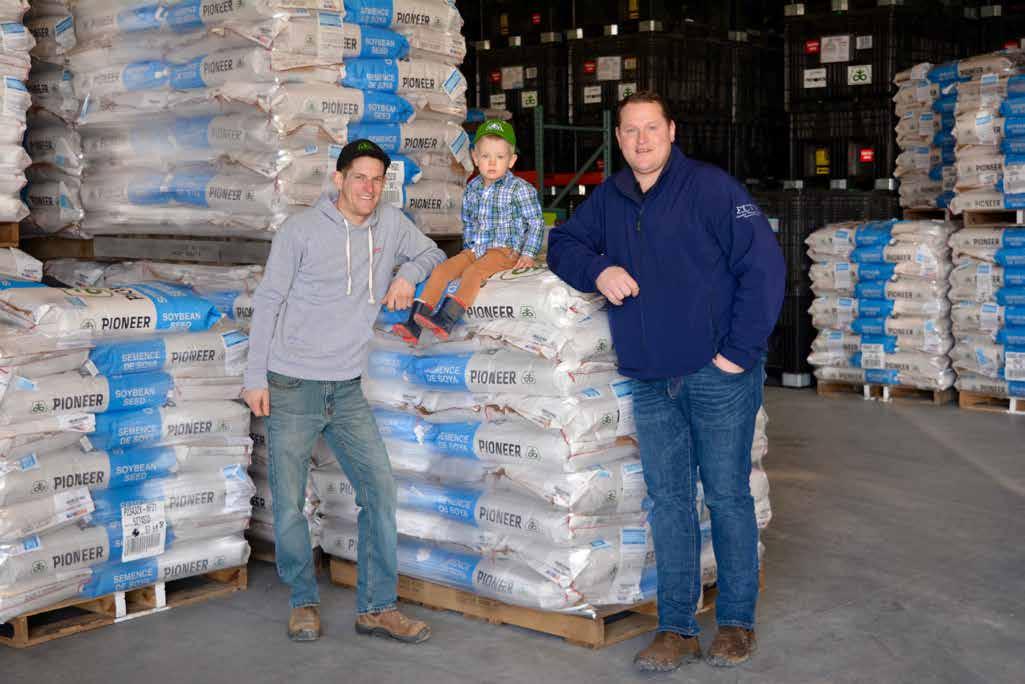

NORFOLK FARMS - SPRING 2024 - A5 Aaron Miedema, Agent cell: 905-741-6392 780 Old Highway 24, Waterford, ON N0E 1Y0 • bus: 519-443-7231 • cell: 905-741-6392 • fax: 519-443-5198 www.ctmins.ca Caradoc Townsend Mutual Insurance Insuring family farms in Haldimand & Norfolk since 1879
Aaron McQueen: AA Crop Company, son Blake McQueen, Aaron Miedema Agent
Carolin Vandenboogaard stands next to the list of extensive products that are available from the retail store at B and C Farms and Butcher Shop. Besides the beef raised on the farm, local pork and chicken are sold as well as value-added products like sausage and bacon.

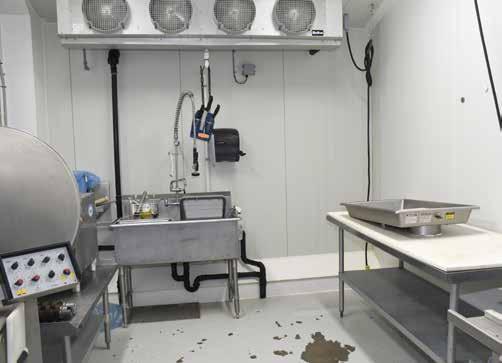
With a full-time butcher, custom butchering is offered for other customers and beef, pork, lamb and deer are cut for customers. The pork, which comes from a neighbouring hog farm, is
cut on site, as is the beef that is raised on the farm.
“We put a lot into raising our beef so we want to ensure it’s cut well,” Carolin said. “If it isn’t
cut right, you could potentially wreck a good piece of beef.”

Ben works part time off the farm and assists with all the trucking along with looking after the cattle. Carolin is kept busy in the shop, either assisting the butcher with packaging and labelling, or working in the retail shop and on Saturdays she goes to the St. Thomas Horton Market. As their business is growing, they also feel that it is time to grow the shop foot print. They are expanding the retail store to give space to display their frozen product for customer to see with their own eyes. Outside of locals, cottagers and tourists are becoming big customers for them.
“People like when they come in here next week, next month or down the road, it’s our beef,” she said. “The pork comes from a farm around the corner. The chicken comes from Poultry Specialties in Tillsonburg and it’s awesome. It’s the uniqueness and constituency of it.”
Today, most of the cows are Limousins, and some are Charolais crosses.
“We like the limos for our feeding program,” Carolin explained. “They are a little leaner but still get marbling. The Angus, for our feed program, they get too fatty.”
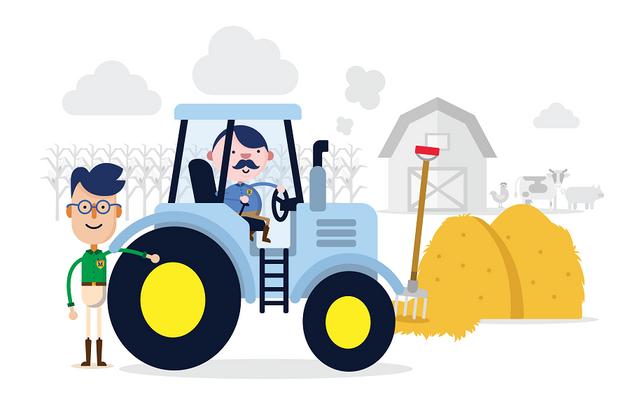


Presently, the cows are taken off site to an abattoir and then brought back to their facility to be hung for 10 - 12 days before they are processed in their shop. Typically, one cow is processed per week but grows to two during the busy months of the year. Butchering is done on site along with fresh sausage, and all smoked items are sent out to Vanessa Meats to be processed.
The farm has come a long way from the run-down buildings that were there initially. Besides the Vandenboogaard’s house, there is a butcher shop with freezer and cooler, a building that serves as the retail store and farm storage and a barn for the cattle. The logo was recently updated from B and C Farms to B and C Farms and Butcher Shop to better reflect the changing business.
Hours are presently Thursday and Friday 10 a.m. to 6 p.m. and Saturday 9 a.m. to 3 p.m. However, Wednesdays will possibly be open after the expansion takes place.
B and C Farms and Butcher Shop is a big turnaround from the farm it once was.
A6 - NORFOLK FARMS - SPRING 2024
We shop farm insurance for you. Aylmer • Delhi • Dorchester • Ingersoll • Kitchener • Langton • London • Norwich • Port Stanley Sarnia • Strathroy • St Thomas • Tavistock •Thamesford • Tillsonburg 519-679-5440 / 888-734-8888 mcfarlanrowlands.com
The cows at B and C Farms are well looked after, which is one of the selling points for customers. The cows are pasture fed and then finished on a grain mix. Carolin Vandenboogaard checks on the cows in the barn.
A shortage of butcher shops during COVID shutdowns resulted in a butcher shop being built at B and C Farms.







NORFOLK FARMS - SPRING 2024 - A7 AGRONOMY SERVICES Field Scouting Custom Application Crop Planning VR Scripts Zone & Grid Soil Sampling HORTICULTURE Specialty Crops Vegetables CROP INPUTS Seed Fertilizer Crop Protection Lawn & Turf Phil Burley, CCA Director of Sales & Agronomy Carl Huff, CCA Sales Agronomist Mark Delaney Sales Agronomist Anna Stephen Sales Agronomist Waterford Location @clarkagriservice Clark Agri Service 519-443-8684 www.clarkagriservice.com 807 Thompson Rd E, Waterford, ON Johanna Lindeboom, CCA Sales Agronomist 289-921-5841 226-931-4923 519-551-1098 289-659-5747
Touch a Truck another success
A fundraiser for a Langton daycare also serves as an educational tool about farming.
The second annual Touch a Truck event in Langton was held on Saturday, April 13 from 10 a.m. to 2 p.m., outside of Langton Little People’s Day Care, the entity it supports.
Jessica Van Laecke, who is one of the organizers of the event with her sister-in-law Candice VanHie. The two attended the Woodstock Touch a Truck in 2022. VanHie is the president of the daycare and saw it as a fundraiser to assist with programming costs.
“We said we could easily replicate this,” Van Laecke said. “That’s really what sparked the idea.”
After the initial event last year, Touch a Truck was back bigger and better this year. The concept of the event is it allows youth, and adults, to take a closer look at the large trucks, tractors and machinery they see on the roads or fields.
“A lot of kids and even adults, they don’t get the opportunity to get up close to see farm equipment and emergency vehicles,” Van Laecke said. “We wanted to provide the opportunity to get up close.”
At the initial event last year, there was equipment along with face painting and bouncy castles. This
year had these attractions, plus a 4-H display with an animal education booth, a kid’s race track for trikes through a straw bale course and characters from Paw Patrol.
Emergency vehicles last year were fire trucks and police cruisers.
This year saw the OPP bring ATVs, an ambulance and the Ministry of Natural Resources. In the latter booth, conservation officer Kyle Mauthe had a display of animal pelts.
“That was another highlight of the day was that trailer with the furs from animals that kids don’t normally get the opportunity to see or feel. That was a really big hit with the kids,” Van Laecke said.
The display count doubled from last year. There were Fendt, Kubota and John Deere tractors, a John Deere articulating tractor, an antique tractor, and a tractor with a tobacco planter. Agriculture equipment was supplied by local farm families, Dey’s Equipment and Norfolk Tractor.
In addition, there was a concrete pumper from East Elgin Concrete, a crane and a surprise hit – the Norfolk Disposal Services garbage truck.


county singer Olivia Mae Graham performed during
a Truck and was a hit with the youth, including the Langton Girl Guides who
attendance.
“Kids loved getting in the garbage trucks,” Van Laecke recounted. “It was just getting to see them. You never get to see them up close.”
Rising country singer and Norfolk County native Olivia Mae Graham performed during the event. She attended Norfolk Little People’s when she was younger.
“She was great with the kids,” Van Laecke said.
The focus of the event was not agriculture, but it was an opportunity to share information about farming to non-agriculture families who have moved into Norfolk County.
Van Laecke is not originally from the area, but is a partner in Horizon Seeds with her husband Curtis, and in-laws Angela and Rick Van Laecke. VanHie and her husband Mike are growers for Horizon. The



A8 - NORFOLK FARMS - SPRING 2024
84 Colborne Street N. Simcoe, ON N3Y 3V1 519.426.5160 goodcas.com 84 Colborne Street N. Simcoe, ON N3Y 3V1 519.426.5160 goodcas.com Strathroy 519-245-9355 WELL Ingersoll 519-485-5252 Toll Free 1-844-290-3053 Licensed with the Ministry of the Environment Like us on Facebook or follow us on ai16152318847_McLeodWaterBusinessCard_Final-Logo-elements.pdf 1 2021-03-08 Drilled Wells & Bored Wells · Pumping Systems mcleodwaterwells.ca · info@mcleodwaterwells.ca
lot of kids and even adults, they don’t get the opportunity to get up close to see farm equipment and emergency vehicles,”
[
Touch
in
“A
Van Laecke said.
Local
were

Patrol character Skye was one of the characters at the event.
Van Laecke family has a history in tobacco growing. With Norfolk County being called Ontario’s Garden, Van Laecke said this event was an opportunity to share information on the area’s agriculture roots.
“There’s always an opportunity to educate,” she said. “A lot of the families that go to that to the day care center are farm families. As the community is growing, some aren’t from a farming background or country background. They see
them (tractors) running down the road but never get opportunity to stop and take a look at one.”
Despite being a windy, cooler day, the turnout was great, with more than 500 people in attendance.
“I heard feedback from some parents saying their kids didn’t want to leave,” Van Laecke said.
As for next year, plans are to make it even bigger and better.










NORFOLK FARMS - SPRING 2024 - A9 51 Queensway E. Simcoe, ON N3Y 4M5 519-426-1680 www.robinsonsimcoe.com In-stock vehicles for everyone’s needs New & Used cars, trucks and SUVs
From left, Ellie Van Laecke, Ella Ryde and Ayla Sooley were three of the youth who attended the event and participated in face painting.
Paw
A blooming experience you won’t want to miss

I have always had a passion for flowers and the beauty they bring to any home or garden. When I was given the opportunity to visit a local greenhouse to gather info and pictures, I knew I would be so in my element and jumped at the chance.
Growing up locally I can remember frequent visits to Berkel Greenhouses, on Conc. 14, and their self-serve stand offering up some of the best greenhouse vegetables around. I was excited to see that Drew and his family, the 3rd generation of ‘passionate green thumbs’, decided to expand their operations from just greenhouse vegetables to the greenhouse floral market as well. Fitting that the new venture reflects both the family heritage and the family name. “Our family came here from the town of Berkel in South Holland and ‘Bloem’ means flower in Dutch so BerkelBloem was born” adds Drew.
Two years ago this past December Berkel purchased the property on Conc. 14 and his vision ‘grew’ from there. The first year he dedicated his time to developing and growing his
greenhouse industry in tropical plants. Their wholesale end of the farming operation specializes in Bromeliads, Ficus, Gardenia, Lemon Cypress, Ellwoodii and two types of Lavender – Spanish and English. They employ 4 full time staff and Mom and Dad are great to help out wherever needed.
“We’re already cultivating and supplying tropical plants wholesale. We’re more than just a greenhouse operation…it’s a testament to the world of floriculture. We have a variety of tropical plants in the greenhouse and now our own unique wonder in Tulips…500,000 in fact” adds Berkel. “We have about 2 acres out of 6 that are dedicated to the flowers. There are 16 varieties to choose from for the pick your own. We were really lucky to have our supplier in Holland come to help us plant our field…He was a really incredible guy”.
Depending on Mother Nature, Tulip picking should begin late April and the Berkel’s will be hosting visitors to their farm for the chance to stroll the fields of blooms. Tickets are $15 and they offer you the opportunity to wander


through their fields, at your leisure, and enjoy the row upon row of stunning, colorful tulips. Your ticket also includes 10 Tulip stems, of your choice, with the option to purchase more stems for just $1.00 each. Entry times are flexible and you can choose yours online or take a drive out to the farm. Tickets can be purchased in advance by going to berkelbloem.ca.
This is not just a chance to stroll through the fields but rather a chance to create unforgettable family memories so pack a picnic lunch, bring your camera and make a day of it. The thousands of Tulips in bloom will provide a beautiful backdrop for lots of photos and family fun. Consider it as a chance to get away from the hustle and bustle of daily life.
The Berkel family -Drew, Melanie, Rory and June - are offering everyone the chance to enjoy this unique experience and welcome Spring 2024 to Norfolk County. The farm is located at 466 Windham Rd. 12 and is set back in from the road. There will be plenty of parking available and lots of wide open space for everyone. Be sure to check them out and follow, on Facebook, at Berkelbloem Take time to stop and smell the flowers!

A10 - NORFOLK FARMS - SPRING 2024
Drew checking the Bromeliads.
Drew & Melanie Berkel.
Drew, June, Rory and Meanie Berkel.

NORFOLK FARMS - SPRING 2024 - A11
New hazelnut cultivars of interest to Ontario producers under development
Encouraging Linda Grimo of Grimo Nut Nursery to describe the properties of a mythical Ontario hazelnut varietal ‘unicorn’ is a cheerful matter of a few moments.
“I would say high yielding, disease resistant, cold weather hardy… the nuts are full, the taste is great,” smiled Grimo during the 15th Annual Ontario Hazelnut Association (OHA) symposium Thur., Mar. 21 inside Tillsonburg’s Royal Canadian Legion, Branch #153.
“Size or shape?” she continued, warming to the exercise. “Not too small, a decent-sized nut is fine, even a medium size, just not too small.”
Grimo completed her description in under 30 seconds. Coming up with a new cultivar however, ‘unicorn’ or not, takes considerably longer.
“It’s really a long process.”
A hazelnut cultivar breeding program takes 18 years to complete says Grimo, from start to public availability. New varieties won’t produce nuts until year three she continued, not in enough numbers of nuts to evaluate fully until year five. The best selections are identified over the next three to four years.
“You are fine-tuning that list.”
Following year eight, the stars, so to speak, are identified and the process of repeating the trial plantings/assessment cycle begins.
The biggest players in the hazelnut breeding world are located at Oregon State University (OSU) in Corvallis, Oregon and Rutgers University in New Brunswick, New Jersey. Universities in Minnesota and Wisconsin are also collaborating on the Upper Midwest Hazelnut Development Initiative. The program is looking at adapting the disease-resistant and cold-hardy trees that produce small American hazelnuts by selecting the best of them that will produce economically viable-sized nuts.
“They’ve gotten a lot of work done,” said Grimo.
There is also ongoing research at The University of Guelph under Professor Emeri-

tus Alan Dale, and from a number of smaller breeders including Grimo’s own program, initiated after Linda’s father Ernie founded the company in 1973.
In very basic terms the search for new cultivars applicable to this province focuses on three main factors: Eastern Filbert Blight (EFB)

resistance, cold hardiness of both tree and catkin, and yield.
EFB is a fungal infection which can render orchards economically unproductive. Rather than a single strain, Grimo describes it ‘moreso as 12 identifiable strains that share similarities.’
“The strains are not real strains, they are groups based on similarities in their DNA.”
Variety in strain and geographical dispersion and varying effect per strain on different cultivars complicates breeding for EFB resistance. Grimo Nut Nursery has two cultivars in development that are showing both cold hardiness and EFB resistance, says Grimo.
“I’d love to be able to say immune, but no one can anymore.”
She uses the example of Gene and Slate hazelnut trees, which have not been affected by EFB for 70 years.
“But I still can’t call them immune because maybe there is an area with a blight that can affect them.”
Cold hardiness refers not only to the tree but also its catkins during the crucial pollen shedding and receiving period. There is a science to hazelnut pollination beginning with compatibility in both alleles (genes) and the timing of pollen shed and flower receptivity. Oregon has a comparatively forgiving three-month span for the latter compared to Southern Ontario’s one-month window.
“As you get colder, that window for pollination shrinks,” says Grimo.
A12 - NORFOLK FARMS - SPRING 2024
Linda and Ernie Grimo continue to be leading proponents of Ontario’s hazelnut industry.
Catkins which shed pollen are also susceptible to a freeze event during that window. There are offsetting factors to that concern however, including John Kelsey’s studies from West Virginia on how a portion of catkins may freeze, but other parts may survive and still emit pollen.
Secondly, she recommends orchard design with a minimum of four cultivars, thereby diversifying shed/receive timing.
“Unless that (freeze) event happens for four weeks during pollination, it’s not going to affect everything.”
[Following year eight, the stars, so to speak, are identified and the process of repeating the trial plantings/ assessment cycle begins.
In that sense, hazelnut production’s complexity can also be its strength, compared to, for example, freeze event devastation Grimo has witnessed in peach orchards surrounding their nursery. Typically, hazelnuts will retain some level of production.
“That’s almost always the case.”
To reiterate, breeding new cultivars is a lengthy process but also one which is ongoing in several key locations throughout North America with the potential to positively impact Ontario growers. Beyond the two varieties in development at her own nursery, Grimo is aware of four at OSU and another four at Rutgers.
“That’s why breeders still breed, it’s that elusive perfection everyone is looking for,” she smiled.
There is a level of competition, but rising above that, an understanding of the value collaboration brings. People share research readily says Grimo in a collective effort to move the industry forward.
“Some might see Ontario as a small cog in a big wheel,” she concluded, “But everyone is working together to keep that wheel turning.”


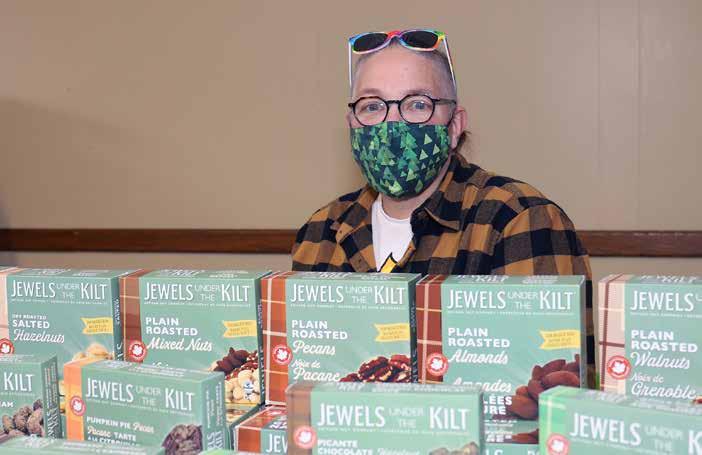

NORFOLK FARMS - SPRING 2024 - A13
Elizabeth Burrow of Jewels Under the Kilt brought a wide selection of her uniquely-flavoured nuts, hazelnuts included, to the 15th Annual OHA symposium in Tillsonburg.
norfolkfarmsnews.ca norfolkfarmsnews.ca/advertise QR CODES Scan the QR code and visit us online
Consider long-term weather trend predictions, but be prepared for fluctuations says Environment Canada meteorologist
There is a joke about the weather in various Canadian locations, in which the punchline states: ‘If you don’t like it, wait an hour and it will change.’
Formulaic translation into an equivalent ‘funny’ on climactic change is not however as simple as extending the timeframe.
Anecdotally, this winter’s lack of ice fishing opportunities, maple syrup tapping timing and experiencing a thunder hailstorm while boiling sap in February provides some indication of historically unusual southern Ontario conditions. Accurately quantifying that within appropriate context is however considerably more complicated.
time period and wider geographical range.
“Not just one station.”
Complicating the process further is the reality equipment has changed over the extended timeframe required for a data set applicable to changes in climate. One needs to ‘clean the noise’ says Cheng, additionally interpreting data as accurately as possible through a broader, holistic approach.
“It’s suggestive but not conclusive,” he said.
‘Climate change’ instead happens over both an extended time period and wider geographical range.
‘Weather’ recognizes day-today locational fluctuations explains Environment and Climate Change Canada Meteorologist Gerald Cheng. ‘Climate change’ instead happens over both an extended
“We still have to dig further.
“We want to ensure what we see, is.”
One can pull historical 19611990 and 1991-2020 data on monthly normals recorded through the Delhi weather station, compare them to each other and add monthly 2022 and 2023 numbers and 2024, through to April 11th. And while they’ll be interesting and possibly include indications of a trend or two, they will unfortunate-

ly not provide a definitive roadmap for southern Ontario farmers facing the 2024 growing season.
“When you look in and drill down you will see fluctuation,” said

A14 - NORFOLK FARMS - SPRING 2024
Gerald Cheng, Warning Preparedness Meteorologist with Environment and Climate Change Canada.
[
Cheng. “And fluctuation is what you have to deal with.”
To a layman’s untrained eye, comparing the graphed data from 30-year averages between 1961 and 1990; and 1991 and 2020 indicates temperatures have gone up roughly a degree between the two time periods while precipitation has levelled out slightly month to month.
For interest and to illustrate the fluctuations Cheng speaks of compared to 30-year averages, the 2022, 2023 and early 2024 numbers break down as follows:
2022 Precipitation Average High Low Median Temperatures
January 46.5 mm -3.0 -13.9 -8.4
February 92.3 0.5 -9.8 -4.6
March 63.8 5.8 -3.5 -1.2
April 61.1 12.3 0.9 6.6
May 63.6 21.3 8.9 15.1
June
2023 Precipitation Avgerage
tures
July
2024 Precipitation Average High
tures
January
To April 11 31 13.3 0.9 7.8
Thirty-year averages tend to smooth things out. However, of note, for example, is January precipitation of 46.5 mm in 2022 compared to roughly twice that in 2023 (89 mm), and again roughly, three times the 2022 value in the first month of this year (152.7 mm).
Temperatures also exhibited similar discrepancies, average lows of -13.9, -3.6 and -5.2 respectively for those three month-long periods.
The fluctuations also illustrate the impossibility of making weather predictions based on historical numbers. There is also significant variance with the percentage predictions based even on the best possible forward-looking data.
For example, Environment Canada predictions suggest a 53 per cent chance temperatures will be above normal through April, May and June of this year, in this area.
“However, what you’re asking is what about the other 47 per cent?” Cheng continued.

‘Be prepared’ for a variety of weather is the best advice for Ontario farmers looking forward to getting crops in the ground and pushing them on through to harvest.
Predictions for ‘near normal’ temperatures come in at 32 per cent he said, below normal at 14 per cent.
“It gives you a signal, but it doesn’t rule out possibilities for other scenarios.”
Similarly, there is a 36 per cent prediction for above normal precipitation through the three-month period, a 34 per cent possibility of normal values and a 31 per cent chance of below normal, a roughly equal division.
Weather station data does provide valuable short and longer-term
insights into both weather and climate.
“But it takes time to arrive at what that means.”
And in conclusion, while it would be wonderful for farmers to have access to a definitive three-month outlook, the more realistic approach is to include a healthy helping of positive outlook and operational flexibility matching weather’s invariable fluctuations.
“I think we have to be prepared,” Cheng concluded, “that’s really the message.”.

NORFOLK FARMS - SPRING 2024 - A15
56.7 27.1 14.5 20.9 August 58.2 27.0 14.4 20.7 September 75 22.0 10.7 16.3 October 36.9 16.0 0.1 9.5 November 35.3 9.8 -0.1 4.9 December 67.1
-3.6 -0.5
80 25.6 12.4 19.0 July
2.6
High Low Median Tempera-
January 89 mm 2.0 -3.6 -0.8 February 74 3.4 -5.8 -1.2 March 144.1 4.7 -3.8 0.5 April 117 14.4 2.5 8.4 May 30.2 20.7 4.8 12.8 June 83.3 24.9 11.8 18.3
18.7 September 76.8 23.0 11.3 17.2 October 63.3 16.2 6.8 11.5 November 51.3 8.5 -2.1 3.2 December 76.5
-0.3
157.6 26.5 15.1 20.8 August 79.9 24.5 13.0
5.7
2.7
Median Tempera-
Low
152.7 mm 0.2 -5.2
44.7
62.3
-2.5 February
5.2 -9.8 0.0 March
8.7 -3.5 3.6

In 2020 Alex and Rachel Hogeveen were enjoying country life at their home on the corner of Thompson Rd. and County Line. They decided they would grow a small sunflower patch-about 10,000 seeds - on their property and run a flower stand at the end of their driveway. The support was so good that they decided they would expand in 2021 and grow they did. Not only did they expand their sunflower patch to three times its size but they decided to add zinnias to the mix as well. That Fall they brought in planters from a local greenhouse to also sell.
The year 2021 saw them make a big change when the opportunity arose for them to purchase a farm just outside Waterford. “We were nervous and excited and quickly got together a plan of what our business model would look like. Rachel’s parents have a background in greenhouses and so we came to the decision to put up a greenhouse and grow planters and hanging baskets” states Alex. “We tested out the waters of selling planters in the fall that we

brought in and it was a success so we solidified that plan”.
Alex was kept busy over winter 2022 putting up a three bay, gutter connect greenhouse which gave them 7,000 square feet of growing space. There were many frustrations and weather delays but they persevered and finished the greenhouse in early March. First plants were ordered that March break, arrived the following week and they were well on their way.
“We saw the joy that sunflowers brought our customers. They bring a bit of happiness to everybody”
The year 2023 saw more growth with more varieties of cut flowers, they doubled the amount of mums they grew and weddings were added to the mix. Their sunflower crop was increased to about 80,000 seeds … about 4 acres of sunflowers. “Traffic continued to pick up at our new farm location on Highway 24 … it brought on so much excitement for expansion in 2024” adds Alex. This year they are adding Ranunculus, Anemone, Lisianthus and a small amount of Dahlias.
Alex adds “2024 is starting off strong with our first ever tulip crop in the

ground and in crates along with many more cut flowers to be grown in time for Mother’s Day. I’m not going to share all of our secrets for 2024…you’ll just have to wait to follow along to find out”.
When it came to naming their new business venture it wasn’t too hard. “We saw the joy that sunflowers brought our customers. They bring a bit of happiness to everybody”. So fit was only fitting that they chose Handful of Joy as the name of their business.
Rachel is putting her creativity to use as they now offer wedding flowers, funeral arrangements, Mother’s Day bouquet/ late Spring subscriptions, and even delivery. With 4 delivery dates you can use the bouquets to spruce up your home or office with flowers that will be fresh every two weeks – May 11th., May 23rd., June 6th. and June 20th. Their delivery service

A16 - NORFOLK FARMS - SPRING 2024
A sampling of their bouquets and Fall mums.
A sampling of their bouquets and Fall mums.
A handful of joy
The Hogeveen family. Rachel, Alex, Avalyn, Emmy & Judah.
[ Bobbi Ann Brady Haldimand – Norfolk MPP B-50 Gilbertson Dr., Simcoe, ON N3Y 4L8 519-428-0446 www.bobbiannbrady.com
covers a wide area and more info and details on this new service can be found by looking them up on Facebook (Handful of Joy) or Instagram @handfulofjoynorfolk. Rachel added that it was easy to come up with a name for their venture. “Flowers bring joy and they’re such a feel- good experience. They bring a bit of happiness to everybody. There’s really not any bad combination of flowers. I’m really excited about working with black and deep red and white, pastel pinks, blues and Peach fuzz – the color of the year”.
The couple receive a lot of help from their families. Alex’s Dad loves working in the garden and is only about 15 minutes away. “Reliable help is hard to find. Our parents have helped us so much and they are a wealth of knowledge”. The help is certainly needed as the greenhouse operation is a sun up to sundown job. ”We’re out here working basically from the time we wake til we go to bed. The kids love hanging out and playing in the greenhouse and the dirt pile. It’s a life style we love”.
The greenhouse typically opens the last week of April or the first week of May (depending on the weather) and will be open Monday, Tuesday, Wednesday, Thursday and Saturday from 8 am to 5 pm, Fridays 8am to 6 pm and closed Sundays. The roadside stand is open 7 days a week from sunrise to sunset.
A flower ‘fix’ is welcome any time and a visit to their greenhouse (once open) will be sure to satisfy and brighten anyone’s day. Be sure to stop at their stand. Flowers always bring a smile to the face!


NORFOLK FARMS - SPRING 2024 - A17 From Earth To Table, We Insure You Every Step Of The Way! 1-800-463-8074 | www.morisoninsurance.ca Norfolk County Homegrown
A sampling of their bouquets and Fall mums.
Ontario Hazelnut Association focus on marketing illustrates positive industry progress
The 15th Annual Ontario Hazelnut Association (OHA) symposium illustrated positive progression within a nascent industry.
While earlier events tended to focus on varietal selection and planting, this year’s agenda featured multiple components investigating marketing opportunities for a growing crop.
“As the industry is growing, you want to ensure the farmers are able to commercialize their product,” said University of Guelph business management PhD candidate Jonathan Parkes Thur., Mar. 21 in Tillsonburg.
Parkes was a featured presenter and also an enthusiastic networker, both sharing and developing information around a joint Ontario Ministry of Agriculture, Food and Rural Affairs (OMAFRA)/OHA study on scalability in the provincial hazelnut industry. Operating
Supporting farmers and farm workers
under the direction of Dr. Kalinga Jagoda, it is titled: ‘Capture the value of Ontario hazelnuts.’
“We’re working hand-in-hand with the OHA on how to tap into that potential,” Parkes explained.
He brings an undergraduate commerce degree in management to the table, building on that formal education in part via interviews with experienced producers. A resident of Guelph, Parkes has embraced an exercise broadening his understanding and respect for the challenges farmers face.
“It has really helped me gain an appreciation.”

effect, rather than simply being the core element in the supply chain, seeking opportunity along
[“That’s essentially what we’re looking at. How do we tap into that and do so efficiently and effectively.” said Parkes.
The study’s title refers to investigating options beyond simply selling raw hazelnuts to processors in bulk, a process seen as failing to return full value to farmers. In

Hello, and happy spring! As the Medical Officer of Health for the Haldimand-Norfolk Health Unit, I wanted to highlight some of the ways our team supports farmers and farm workers in our community.
We provide seasonal housing inspections to ensure it meets regulatory requirements and provides a healthy living environment for our International Agricultural Workers.
Free water testing services are available to ensure the water from your small drinking water systems is safe for drinking and agricultural use. There are a variety of convenient vaccination clinics to help you and your workers stay protected against preventable diseases like measles, influenza and COVID-19. Additionally, farm workers are welcome to receive a dose of measles containing vaccine through routine monthly vaccine clinics.
Our staff are here to assist you in finding essential healthcare services
within Haldimand-Norfolk, making it easier for everyone to access medical care when needed.
For further information or inquiries, please don't hesitate to contact our Environmental Health Team hotline at 519-426-6170 ext. 3477 or email at ehthotline@hnhss.ca. You can also visit our website at hnhu.org/seasonal-housing.
Our priority is your health and well-being, and we're committed to supporting you in maintaining a healthy lifestyle while working on the farm.
Dr. Joyce Lock Medical Officer of Health Haldimand-Norfolk Health Unit
the extended value chain between producer and end consumer.
“That’s essentially what we’re looking at,” said Parkes. “How do we tap into that and do so efficiently and effectively.”
Jennifer Ross, Executive Director, Ontario Co-operative Association was on hand to encourage consideration of the collective approach summed up in the International Co-operative Alliance definition.
‘Co-operatives are people-centred enterprises owned, controlled and run by and for their membership to realize their common economic, social and cultural needs and aspirations,’ it states.
The Ontario Co-operative Association (https:// ontario.coop) is in effect, a co-op for co-operatives, offering educational tools and resources for close to 100 related organizations within the province. Co-ops have a business component serving their members’ needs said Ross during her presentation, as well as the cornerstone of democratic governance from their membership. They require capital to get off the ground and the willingness to work together to better

A18 - NORFOLK FARMS - SPRING 2024
Jennifer Ross, Executive Director, Ontario Co-operative Association, spoke on the benefits of a collective approach for farmers.
Jonathan Parkes was a featured presenter at the 15th Annual OHA symposium Thur. Mar. 21 in Tillsonburg.
accomplish goals which would be challenging individually.
She cited several co-operative enterprises as examples including Gay Lea Foods, founded by 1,300 dairy farmers in Ontario and Manitoba; and the Ontario Dairy Goat Co-operative (ODGC).
The ODGC was formed by producers with the goal of marketing and shipping members’ milk for the best achievable price, said Ross. New members pay a one-time membership fee and must also purchase shipping shares. In return, they receive transport, quality control services and a product pool large enough to attract and retain larger clients.
“They wouldn’t be able to do that individually,” said Ross. “One farmer is not going ‘I have three litres of milk,’ they’re saying ‘Our co-op has 1,000 litres.’”
It’s a method of creating critical mass and dependable supply a major grocery chain would require prior to committing to adding products and dedicating space on a shelf. The approach also creates the potential for better return through negotiating from a stronger position representing larger numbers of producers with shared interest.
The co-operative model is extremely versatile says Ross.
“It’s really unique to your industry, you can tailor it to what you want.”
They can be run in various models including for-profit or not-for-profit, directing surplus funds directly back to members or alternatively, into industry-building initiatives. However, as other business models, they must be based on a solid and successful business plan.
“It needs to make money, it needs to be viable,” said Ross.
The co-operative difference, she concluded, is in who owns the entity, who controls it and who benefits from surpluses at the end of the day.
“And why shouldn’t it be the farmers?”
Recognizing local commitment and achievements
In 2014 the Norfolk County Heritage & Culture Department established the Norfolk County Agricultural Hall of Fame. It was started to “recognize locals for their achievements in agriculture. Inductees are based on one’s achievements, results, benefits and innovations accrued to agriculture and rural development on a local and/or broader basis as a result of the nominee’s volunteer and paid activities.”
Some past winners include Harry B. Barrett, Larry Chanda, Ron Judd, Hellyer Ginseng, Kernal Peanuts…just to name a few. If you know of someone who you feel is worthy of recognition for their contributions to Norfolk County’s agriculture or rural history you can get an application form at Waterford Heritage & Agricultural Museum, 159 Nichol St. W. in Waterford Wednesday through Saturday from 10 a.m. to 4 p.m. You can also download a form at www.norfolkheritage.ca .
Nominations for the award are open until 4 p.m. June 29, 2024. The Ceremony to induct winners will take place at WHAM in September. If you have any questions you can contact WHAM during their open hours by stopping by or by calling them at 519-4434211.



NORFOLK FARMS - SPRING 2024 - A19
From left, Jim Cornish, Dave Sealey and Francis Cornish hold down duties at the Growers Mineral Solutions booth.

A Government of Canada press conference announcing downward adjustments in the nation’s numbers of temporary foreign migrant workers certainly got Foreign Agricultural Resource Management Services (F.A.R.M.S.) president Ken Forth’s attention.
Quickly, he fired off emails to three top bureaucrats.
“I got a phone call back in less than five minutes,” said Forth, conversation essentially assuring him cuts were not related to agricultural programs.
“I think we’re OK for now,” he said. “But only for now.”
An Employment and Social Development news release dated March 21, 2024 indicated Minister of Employment, Workforce Development and Official Languages, the Honourable Randy Boissonnault, had announced limit-

ed-time Temporary Foreign Workforce Solutions Road Map (WSRM) measures will not be renewed and additionally, end earlier than planned.
As of May 1, 2024, employers identified in the 2022 WSRM will have a reduction from 30 per cent to 20 per cent of their total workforce which can come in through the Temporary Foreign Worker Program under the low wage stream, with an exception for construction and health care sectors.
Employers will also be required to explore every option before applying for a New Labour Market Assessment (valid now for six rather than 12 months), including recruiting asylum seekers with valid Canadian work permits. The intent, says the release, is to ensure the program is used only in cases where no Canadian workers can fill necessary roles.




“Today, we announced our intention to reduce Canada’s reliance on temporary foreign workers and encourage employers to find the talent they need right here, at home,” said Minister Boissonnault. “The time-limited measures we introduced in 2022 were necessary as our labour market was facing unprecedented conditions – but now, as times change, we




A20 - NORFOLK FARMS - SPRING 2024 3503 HWY# 3 W SIMCOE 519.426.1090 2173 HWY# 3 E JARVIS 519.587.2273
F.A.R.M.S. President Ken Forth assured temporary foreign migrant worker cuts not related to agriculture Bobcat of Brantford, Inc. BRANTFORD, ON (519) 752-7900 2.713” x 0.93” Bobcat ®, the Bobcat logo and the colors of the Bobcat machine are registered trademarks of Bobcat Company in the United States and various other countries. ©2021 Bobcat Company. All rights reserved. Never get thrown off your game. Head to your local dealer, and buck against the biggest challenges with Bobcat performance, versatility and toughness. Bo B cat .com
Ken Forth
“Bobcat ® equipment helps me tackle the most rugged and challenging projects on my ranch.” http://www.bobcatofbrantford.com BOBCAT Bobcat ®, the Bobcat logo and the colors of the Bobcat machine are registered trademarks of Bobcat Company in the United States and various other countries. ©2024 Bobcat Company. All rights reserved. 21976365 Never get thrown off your game. Head to your local dealer, and buck against the biggest challenges with Bobcat performance, versatility and toughness.
Jess Lockwood Professional Bull Rider
must ensure our Temporary Foreign Worker Program reflects our current needs.”
The press release indicated job vacancies were at a record high of 983,600 in the second quarter of 2022, however fell to 678,500 in the fourth quarter of 2023.
“Our labour market needs are tightening, so should our policies,” added The Honourable Marc Miller, Minister of Immigration, Refugees and Citizenship Canada, via the release. “Today’s announcement prioritizes our country’s needs to have enough construction workers to build houses, early childhood educators to teach our kids, and health-care workers to treat patients. As we gradually reduce our reliance on temporary foreign workers, we will continue to help employers fill job vacancies while supporting Canadian workers.”

“I
Announced in 2022, the WSRM applied to the following seven sectors: food manufacturing, wood product manufacturing, furniture and related product manufacturing, accommodation and food services, construction, hospitals, and nursing and residential care facilities.
To reiterate, Forth was assured the cuts are not for agriculture. It would ‘be nice’ he continued if that was explicitly defined.
“They don’t, but our indication is it has nothing to do with us.”
The F.A.R.M.S. president’s long-term dealings with bureaucrats gives him confidence they are ‘pretty straight up’, although may be limited in how much they are able to communicate.
The March 21 press release did have two specific references to agriculture, firstly Budget 2022’s commitment to developing a new foreign labour program ensuring access to a stable and reliable labour supply, while strengthening worker protections.
It also referenced a $49.5-million Budget 2021 expenditure implementing a new Migrant Worker Support Program intended to better support worker needs.
Agriculture does employ many Canadians as well Forth continued, however there is an ongoing need for an influx of seasonal employees.
“We need an army of people to hand-harvest crops - that’s the way it works.”
Forth says roughly 60,000 of Canada’s 240,000 temporary foreign workers are employed in agriculture and are integral to its successful operation.
“They are essential, it’s over if they’re not here.”


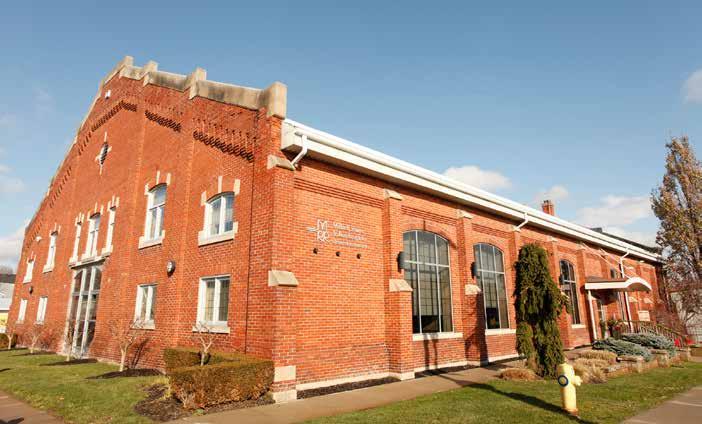
Family matters
The agriculture specialists at Millards will help you pass along your family business, assist your
or
The agriculture specialists at Millards will help you pass along your family business, assist your children or grandchildren with the financial operations, and make sure the transfer is fair to your family members who aren’t continuing with your farm business.
Tax advisors
Tax advisors
FAMILY MATTERS
The Millards team has farm tax expertise to guide you through the changes to the small business deduction as
The Millards team has farm tax expertise to guide you through the changes to the small business deduction as well as advising you on issues that affect your lifetime capital gains exemption when it comes time to sell or transfer your farm.
The agriculture specialists at Millards will help you pass along your family business, assist your children or grandchildren with the financial operations, and make sure the transfer is fair to your family members who aren’t continuing with your farm business.
Specialized expertise
TAX ADVISORS
The Millards team has farm tax expertise to guide you through the changes to the small business deduction as well as advising you on issues that affect your lifetime capital gains exemption when it comes time to sell or transfer your farm.
The farm specialists at Millards have a long history assisting clients with government farm programs and accounting software, enabling you to focus on managing your business.
SPECIALIZED EXPERTISE
focus on managing your business.
The farm specialists at Millards have a long history assisting clients with government farm programs and accounting software, enabling you to focus on managing your business.
NORFOLK FARMS - SPRING 2024 - A21
Char tered Professional Accountants Consistently ranked one of Canada’s top 20 CPA firms. NORWICH 519.863.3554 TILLSONBURG 519.688.9991 SIMCOE 519.426.1606 DELHI 519.582.3110 PORT DOVER 519.583.9994
children
operations,
fair to
family members
business.
grandchildren with the financial
and make sure the transfer is
your
who aren’t continuing with your farm
well as advising you on issues that affect your lifetime capital gains exemption when it comes time to sell or transfer your farm. Specialized expertise Char tered Professional Accountants Family matters
clients with government farm programs
software,
you to
Char tered Professional Accountants Consistently ranked one of Canada’s top 20 CPA firms. NORWICH 519.863.3554 TILLSONBURG 519.688.9991 SIMCOE 519.426.1606 DELHI 519.582.3110 PORT DOVER 519.583.9994
The farm specialists at Millards have a long history assisting
and accounting
enabling
Char tered Professional Accountants
Consistently
firms millards.com
ranked one of Canada’s top 20 CPA
SIMCOE 519.426.1606 PORT DOVER 519.583.9994
[ WATERFORD Truck & Trailer norfolkfarmsnews.ca norfolkfarmsnews.ca/advertise QR CODES Scan the QR code and visit us online
got a phone call back in less than five minutes,” said Forth
Feeding the gangs

If you grew up in Norfolk County then you have, no doubt, seen your fair share of tobacco fields and kilns and watched the progression of its harvest over the years. Delhi Tobacco Museum Curator, Andrew Moore, is very proud of one of his latest displays ‘Feeding The Gangs: Culinary Arts On The Farm’ commemorating the work of ‘tobacco wives’ on the farms over the years.
“In the 50’s and 60’s, at the height of local tobacco production, women played a huge role on the family farm. I wanted to highlight the women’s labour on the farms from raising the children, managing the farm, feeding 15 to 22 workers 2 to 3 times a day (largely done by themselves), hanging the kilns…they were Jacks of all trades. Back then it was ‘all hands on deck’.”
To commemorate their work and to enlighten visitors to the Museum with the early days of tobacco harvest and the primary role of the women, Moore and his staff have set up an
authentic mock kitchen from the mid 1950’s. The appliances, utensils, cookbooks, ‘food’… everything there will give you a very good idea of just how things were and the challenges the farm wives faced and overcame.
The second part of the display features cookbooks and recipes from some of those farm wives and on my visit, they were featuring Shirley Glendenning. The Glendinning family grew tobacco locally from about 1953 to 1988. “Planning was extraordinary for them. They fed the workers ‘regional meals’ depending on their heritage be it Belgium, Chinese…wherever they came from. I wanted to highlight the multiculturalism of the day.”
Moore adds “Their stories are all slightly different. There was a lot of change over 3 to 4 decades and I wanted to feature that. When refrigeration came in it made things much easier for the farm wife. The display is going to run for a few months, probably until about the end of the year, and each month will feature a new


farm wife and new recipes. Their stories are all slightly different…we’ve been getting a lot of good feedback” adds Moore. “Our next farming wife to be featured will be Mrs. Henry Chanda, publisher of two cookbooks”.
Moore has been Curator at Delhi Tobacco Museum and Heritage Center since April 2023 and prior to that he was Assistant Curator. “People are really nice here. A lot of people have taught me so much about Norfolk County’s history and helped whenever help was needed.”. Moore encourages visitors to the Museum to stroll through the entire Museum – upper and lower floors – to get an even better understanding of not only tobacco life in its early days but a history of the entire area as well.
Adds Moore,” We will be featuring a large photo exhibit, in May, highlighting some of the old kilns still standing”. This, along with his culinary display and the many old, original tobacco artifacts offer a step back in time, to ‘the good old days’. The Museum is open Wednesday through Saturday from 10 am to 4 pm and admission is by donation.

A22 - NORFOLK FARMS - SPRING 2024
Shirley Glendenning
A typical mid 1950’s harvest kitchen.
Curator Andrew Moore
Victorian era dowry becomes 21st century “ecological gift” for LPRCA
A tract of local mixed forest that was once part of a dowry is one of several forested tracts of land donated to the Long Point Region Conservation Authority (LPRCA) through a federal program.
The 20.23 hectare (50 acres) Gage Tract on the seventh concession of the former Windham Township formerly belonged to the Gage family, before being given to the LPRCA through the federal Ecological Gifts Program in 2020, said LPRCA manager Judy Maxwell.
The Ecological Program enables Canadians with ecologically sensitive land a means to protect nature and preserve it for future generations. Created in 1995, the program offers significant tax benefits through the Income Tax Act to donors who donate land or a partial interest in land to a qualified recipient.
In this case, the qualified recipient is the LPRCA. “There’s lot of history here,” said Maxwell about the tract, located between Highway 24 and the East Quarter Townline Road.
The sign at the Gage site states that the four daughters of the late Robert and Lucy Gage donated the land in memory of their parents and their brother, Bill.
“In 1892 this 50-acre parcel was the dowry of Roxa Beemer in her marriage to William Gage. It was inherited by their son Russell Gage and then passed on to his son Robert Gage. The great-granddaughters of Roxa and William
Beemer donated the Gage Tract to LPRCA stewardship,” reads the sign.
Roxa Beemer was born in the former Townsend Township in 1859 to Elias Beemer and Agnes McKerlie. The Beemers were a prominent pioneer family. William Smith Gage lived between 1859 and 1918. Records show that their son Russell married Jean Mildred Collver in Simcoe in June, 1919.
The tract consists of mixed deciduous and coniferous trees which the authority monitors through its sustainable management policies.
To date, woodland restoration on the Gage Tract involved treating and removing trees affected by the Scotch pine beetle, said LPRCA publicist Jessica King.
The federal program requires that each donation must be certified as “ecologically sensitive” according to specific provincial and federal criteria before being accepted under the program. Details about the program can be found online.
Maxwell said that the authority has had various donation arrangements between the authority and land owners wishing to keep and care for natural tracts in perpetuity. “But ecological gifts are a nice tax advantage as they have no capital gains, and you get a tax receipt for your donation.”




• Onion bins, carrot bins, potato bins, cabbage bins & apple bins
• Onion bins, carrot bins, potato bins, cabbage bins & apple bins
• Pre-cut components
• Pre-cut components
• Ash & Oak hardwood good for outdoor use
• Ash & Oak hardwood good for outdoor use

• Diagonal corner post, pre-cut & ready to nail
• Diagonal corner post, pre-cut & ready to nail
• CFIA heat treat certified
• CFIA heat treat certified



NORFOLK FARMS - SPRING 2024 - A23 For farm, landscaping,
surveying
For farm, landscaping,
Pencil Pointed Stakes Pencil Pointed Stakes
land
& more!
land surveying & more!
P roud l y Canadia n Vegetable & Produce Bins Vegetable & Produce Bins HARD WOO D EXPE R T S SE R VI N G T H E LO CA L FARM I N G C O MMUN IT Y FO R 50+ YE AR S Made from quality hardwoods Made from quality hardwoods R e spo ns ibly m a n agin g , harv es ti ng a nd sawin g timb er i n so u thwe s t e rn Onta r io s in ce 1 9 59 townsendlumber.com Sales Office 519.842.8234 info@townsendlumber.com 1250 Jackson Side Road, Courtland, ON PLUS...all-natural wood chips, mulch & shavings Sustainably sourced materials • Bulk delivery & custom sizing available
The LPRCA’s Gage Tract is located in the seventh concession of the former Windham Township
Ontario’s Liquid Gold: An Interview with Master Beekeeper Amanda Henderson
Golden Horseshoe Beekeeper’s Assocation Director At Large Amanda Henderson had no idea that her dad’s suggestion in 2010 to begin beekeeping together would eventually lead her to both a full-time career and also a flourishing sideline business. Empowered by the ‘Introduction to Apiculture’ course from the University of Guelph and advice from a beekeeping uncle, Henderson has grown her initiative into a 100 hive apiary, where boxes stored in and around St. George yield liquid and creamed honey, beeswax candles, queens and nucs for sale.
As someone who started out small and has grown over time, Henderson was the perfect person with whom to inquire about start ups: “If you are looking to get started with honeybees- do your research, we have many great resources here in Ontario. The Honeybee Research Center at the University of Guelph, the Ontario Beekeepers’ Association through their meetings and the Ontario Bee Journal as well as their courses offered through the Technology Transfer Program and local beekeeping associations like the Golden Horseshoe Club are all great ways to get started- and help you meet people in the industry. There are also workshops and courses offered by some of the different beekeepers and bee supply stores, and mentorship can be a great way to try beekeeping before you make the financial investment and get your own bees. Just make sure that your information is coming from a credible source- there
is also plenty of misinformation online!”
When asked about the concerns larger operations have about small start-ups, treatment and careful oversight seemed to be the antidote to those concerns: “Any bees that are not regularly managed, checked and treated will be a major threat to the colonies nearby. This has nothing to do with how many colonies somebody owns. What is important to keep in mind is that honeybees are a managed livestock that will require ongoing maintenance, management and financial investments. If you are not in a position to learn how to properly care for your bees, and put the time and resources into looking after them, then you risk putting other beekeepers in your area at undue risk. Since honeybees can fly for several kilometers from each hive we can’t control where they go during the day. So, what happens is- say you have a yard of bees that have not been treated or monitored, and they have high levels of mites, or maybe a Foulbrood disease. As those bees start to die out and collapse from their pest/disease- the neighbouring bees will find any honey stores left in those dying hives and rob it out (take honey from the dying hive and bring it home to their healthy hive). While the healthy bees are robbing the honey they are also picking up the mites or disease spores and


bringing them home as well, and spreading infections.”
Although Henderson sights multiple stressors which have contributed to major industry losses over the past few years, she sights the parasitic Varroa Mite as the largest threat to the bee population. “If we were to put it into human perspective- it would be like having a tick the size of a small plate feeding on an adult human.” She goes on to
the treatment options have limitations like resistance, temperatures requirements, and withdrawal periods before honey boxes can be put on a treated colony, hope is on the horizon as several universities are actively researching honeybees, and new treatments are on the horizon which will hopefully provide better management of varroa mites.
Some things about beekeeping

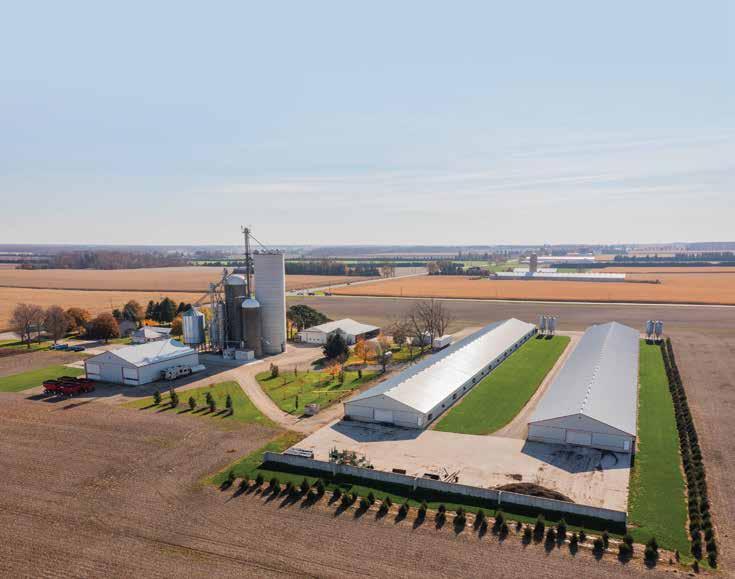


A24 - NORFOLK FARMS - SPRING 2024
Amanda Henderson, master beekeeper from St. George, Ontario shares her wealth of knowledge.
Worker bees undaunted by their task.
tario to have a diverse landscape with a wide variety of blooms for the bees to work. The season starts with Maples, Willows, Coltsfoot and Dandelions in March/April, and continues through until September/October ending with Asters and Goldenrod. In between some of the major blooms are Black Locust, Clover, Alfalfa and Basswood. Honeybees are great generalist pollinators- so there are so many ornamentals


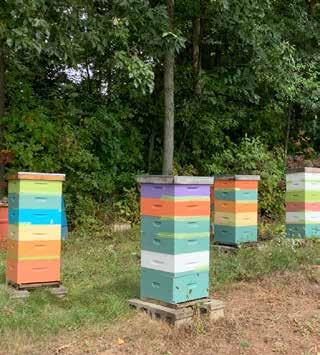
and other shorter blooms throughout the season.” Henderson suggests that those wishing to help the honeybees plant blooming cover crops like sunflowers, clover, phacelia, sainfoin and borage, or trees like Horse Chestnut, Basswood, and Black Locust. Those who may not be in the position to plant can also help by letting nature take its course: letting dandelions bloom and leaving natural areas around fence rows and wetlands are also to many pollinators.
In addition to her thriving sideline business, Henderson was able to use her degree from the University of Guelph coupled with her newfound passion for bees as a full-time career working at a queen breeding operation out of rural Hamilton, at which she has spent the past decade seeking breeding stock that are particularly gentle, hygienic, and efficient in the brood chamber, to be sold to beekeepers across the nation.
At the Golden Horseshoe Association, Henderson helps to make decisions regarding programming, which includes monthly members meetings where guest speakers inform on honeybee research, advancements, business models, bee related gadgets, and the like. They also
offer outreach sessions to school groups, and are planning on implementing teaching hives.
Henderson also thinks the taste coupled with the health benefits of honey is “the bees knees”, noting honey’s well known benefits of wound treatment, cough suppression and aid with allergy symptoms as reason alone to switch to the natural sweetener. She suggests checking out the Ontario Beekeepers’ Association “All About Honey” page on their website for great honey recipes (https://www.ontariohoney.ca/ all-about-honey/recipes), and also sights that website as a resource to a provincial directory to find the beekeepers closest to the consumer: “Beekeepers are such a passionate and diverse group of people it doesn’t matter where you live you will find someone near you producing honey, and helping to maintain a healthy pollinator population!”
Lastly, Henderson, like so many beekeepers, is happy to pass along her wealth of information: “If anyone wants more info- they can find me at Henderson Apiaries on Facebook.”
Legal Solutions for Ontario’s Garden



NORFOLK FARMS - SPRING 2024 - A25
Capped honey frames.
Worker bees packing the frame with pollen.
The finished products - labours of love.
Visit brimage.com /agri-law or call 519-426-5840 Business & Organization Contracts & Agreements Farmland & Real Estate Tax & Municipal Estate & Family Employment & Labour Comprehensive legal guidance for Farms & Agri-Business from the law firm with deep agricultural roots. You’re in good hands at Norfolk’s Legal Cornerstone.
Niagara Christian Gleaners:“an economical way to transform growers’ produce”
In 2018, the Niagara Christian Gleaners (NCG) opened a dehydration plant in West Lincoln in order to feed food-insecure populations both internationally and domestically. Not surprisingly to them, area farmers’ generosity to provide vegetables and fruits to this Smithville-area plant is so positive that the plant expanded.
This non-profit group takes surplus produce from the Niagara-Haldimand-Norfolk area, and dehydrates it into bags of quality product that keeps well in both hot and cold climates.
“Canada is a net producer of food --we likely can’t eat everything we produce,” said general manager, Pete Wierenga. “For instance, Kenya had a four-year drought, and then had the worst flood in years. Their famers who can grow food --can’t -- and they’re hungry themselves. That is the difference between us and others.”
In 2023, the Gleaners processed a record 1,466,253 kg (3,232,534 pounds) of fresh vegetables and fruit, more than double its total combined production in 2019 and 2020.
“Our current production rate fills approximately one sea container per month, or 1.2 million servings of food,” said Wierenga. “This translates into 13.1 million servings of food aid which landed in nine different countries.”
Farmers truck in trailer loads of surplus and graded-out produce. From there, approximately 80 volunteers re-wash, peel, chop, and cut off blemishes and skins. They then enter these pieces into a dicer, which reduces them into three-eight inched cubes. They layer the cubes on trays for dehydration, measuring 21 trays per rack, totaling 700 trays per dryer. Dehydration
begins in the afternoon, with a change-out crew coming in at night to complete the process.
The end product is attractive and nutritious. For example, Wierenga said that one package of pears, parsnips and carrots yield a four-cup, family-sized quantity, with 27 servings per bag. Each NCG box provides approximately 500 servings.
“It’s an economical way to transform the growers’ produce,” Wierenga explained.
Several aid groups vetted by the NCG later remove and ship the completed sea containers.
“They (distributors) connect with us and seek out our food. They’re the boots on the ground and know where the need is. They know how to get it there and not have it intercepted for sale. We keep the list short so that we are sure of that it gets there.”
[“Our current production rate fills approximately one sea container per month, or 1.2 million servings of food,” said Wierenga.
The distributors usually ship out full containers; however, one organization, St Catharine’s Warehouse of Hope, recently took a partial container in order to blend in school and hospital aid for the Ukraine, said Wierenga.
Their motivation is the biblical mandate of gleaning, in which God instructs farmers to leave a portion of their crops in the fields for the
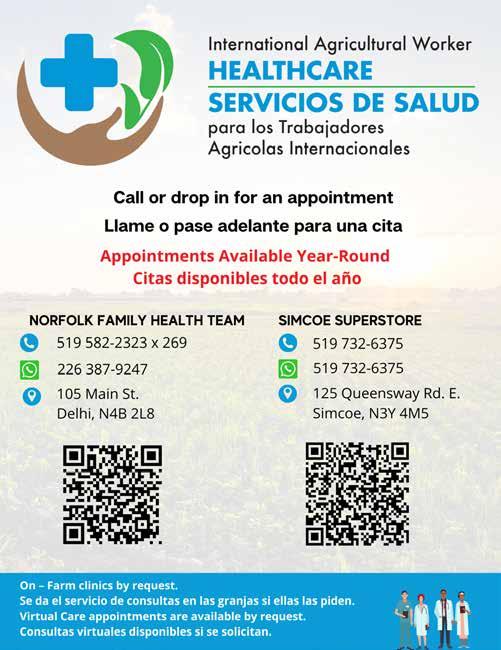

poor to gather or “glean” (notably in Leviticus, Deuteronomy, Exodus and Ruth).
“We’re unashamedly a Christian organization-- we do it in Christ’s name,” said Wierenga.
People from all age groups, including youth, share this vision: the NCG utilitized more than 60,000 volunteer hours in 2023 in order to transform the produce into dehydrated nourishment.
The Gleaners also welcome visitors and school groups to view their work and learn about food insecurity and social justice.
NCG is loosely affiliated with the original Ontario Christian Gleaners near Cambridge. However, both groups have separate plants, websites, volunteers and boards of directors. When the Cambridge site ramped up its production with more tractor trailer loads of
CONSIGNMENTS WANTED
THE WALPOLE ANTIQUE FARM MACHINERY ASSOCIATION'S summer Online Farmers Consignment Auction Bidding will open on Saturday July 13th and close on Thursday July 18th.
Consisting of tractors, farm & irrigation equipment, trailers, fork lift, lawn & garden, miscellaneous items PLUS antique tractors & equipment.
We have early consignments from 2 farms. Farmers If you have 1 piece or a full line of equipment to consign contact us. We have equipment to unload with and a loading dock.
We are raising funds to update our Sea Can Kitchen. LOCATION: 3070 Highway 6, Jarvis ON.





Consignments Wanted



A26 - NORFOLK FARMS - SPRING 2024
NCG general manager Pete Wierenga.
To consign, call FREEMAN JOHNSON 289-880-7753 LOCATION 3070 Highway 6, Jarvis, Ontario hibid.com Gerald Bowman AUCT IO NS & APPR AI SAL S bowmanauctions.ca
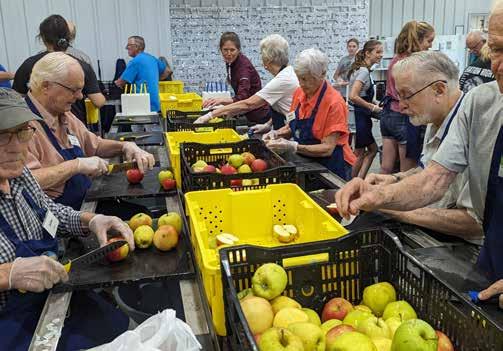
produce, Wierenga said that several Niagara residents believed that they could replicate this need locally.
“It was a small group of visionary people in 2015 who thought they could set up their own plant. They knew that there would be a number of volunteers who would come to serve in Niagara. Ontario Christian Gleaners were at capacity – they saw that there would be enough food available for more dehydration.”
NCG began construction on their West Lincoln site in 2018. Wierenga said that they raised the $2.5 million dollars needed to build it entirely through donations with no government funding. It opened five months later debt-free.
The Niagara plant quickly reached capacity as “the need for food was great,” said Wierenga.

In 2021 the group installed an additional natural gas dehydrator. “The second dehydrator doubled capacity,” said Wierenga.
The current expansion totals 5,000 square feet, providing provide additional storage, including two new coolers for the intercepted produce and finished packages. “We’re in the home stretch with the building, but the coolers and equipment need completion, hopefully by summer,” said Wierenga.
The Gleaners installed a heat recovery system on Dryer Number 2. Its units capture available heat from their exhaust air and reroute it into the incoming air way; it’s a means of preheating the air before it enters the dryers. Another recovery system for the other dryer is currently in the works.

“We were spending upwards to $10,000 on natural gas. Our large operating budget depends upon donors.”
While NCG’s figures seem impressive, Wierenga fingers farmers as the “key piece” of this work. “We give it all away. The giver is really the growers; we transform it into dehydrated food which has an almost infinite shelf life, is stable, and has a condensed size so put a lot in a sea container, product can land in any climate with little or no refrigeration.”
“Our piece of the puzzle is transforming that produce into something safe and transportable.”

Daylight Savings Time created to preserve coal reserves, not to “help farmers”
While most Canadians are no longer dependent upon coal to heat and light their homes, one of its most infamous consequences – the annual time change -- continues to vex people.
Daylight Savings Time (DST) reportedly began a century ago as a means of saving coal, with Canada being one of the first nations to adopt it. DST began in Port Arthur, now part of Thunder Bay in 1908. Montreal did the same 10 years later.
Back then, lighting a home in the evening consumed much of the household energy. But today’s energy-sapping appliances such as air conditioners, heaters and electronics consume renders this original motive as moot.
Today, about 1.6 billion people use Daylight Savings Time, with many countries adopting it in the latter half of the twentieth century.
But now many people question this biannual custom of moving clocks by an hour, citing statistics about higher traffic accidents, heart attacks and other emergencies linked with the disruption of human circadian rhythms.
Inevitably, Canadians cite the urban myth that DST began in order to “help farmers work longer” – despite its disruption to milking times, the logic of working by daylight, and night lights on farm equipment.
Yet several portions of Canada rejected DST. Saskatchewan rejected it with the Saskatchewan Time Act in 1966. Yukon rejected it in 2021. Portions of British Columbia, Southampton Island in Nunavut and three locations in the eastern tip of Quebec stick to Standard Time.
Meanwhile, some countries – South Africa, India, China and the Philippines abolished it.
In 2020, the Ontario Legislature passed a private members bill, Bill 214 – the Time Amendment Act –to keep clocks at the same time each year – but on the condition that neighbouring Quebec and New York State follow suit.
When this happens is unknown. In March, 2023, the US Senate passed the Sunshine Protection Act to make Standard Time permanent effective in November of last year. The Sleep Foundation website states that implementation remains stalled and has yet to come up for a vote this year. Also, dozens of states remain undecided whether to stick to permanent Standard Time or Daylight Savings Time.
Until then, millions of sleepy Canadians and Americans continue to “spring forward” and “fall backward”, and get up to go to school or work every spring morning in the dark.
NORFOLK FARMS - SPRING 2024 - A27
NCG’s volunteer corps relies upon people of all ages.
Freshly-delivered vegetables from Norfolk County awaits processing.
A finished bag of dehydrated vegetables yields 27 servings.
Volunteers handle the morning production from intake to bagging and storing the finished product.
Heeding the call of the bison: Mike Waters reflects on unexpected career in farming

Mike Waters is grateful for the support from friends and family that he’s received over the years – in many ways, the kindness of others helped to set the trajectory of his life.
“I came from the streets of Hamilton,” said the Hagersville resident, who owns Springvale Bison Farm with his wife, Michelle Waters.
Waters lived in foster care from the age of nine until he was about 12, when he went back to living with his mother and stepfather, but that didn’t last long.
“My parents were not good parents,” he said. “It happens.”
From the age of 14 to about 18, Waters lived on the streets and was a member of a gang before he was able to start building a more stable life for himself. At 23, Waters became a Christian, and about five years after that, “I felt a call in my heart from the Lord to start raising bison,” he said.
There was just one problem.
“I knew nothing of farming at all,” Waters said.
At the time, he and his then-wife were living in an apartment in the city with their first child.
“I needed to find a farmer who could teach me to farm, who had an extra farm,” Waters said.
He was able to connect with Lloyd Ramsey, who had a dairy farm between Brantford and Ancaster.
“He started to teach me to farm, and a year later, we moved into a house that nobody had lived in for 60 years,” Waters said. “I knew nothing about carpentry, plumbing, electrical – nothing at all, because I was street smart. Luckily, I had enough friends that came and helped to put the house together.”
Ramsey’s property had two farms. Shortly after Waters and his family moved in, Ramsey switched from dairy to beef cattle, and Waters ran the operation for him, learning along the way. In the meantime, he rented the second farm. About two years after they moved in, Ramsey bought Waters his first five bison, which he raised on the second farm.
“That was the start of it,” Waters said.
The Waters family stayed on the Ramsey farm for about a decade. In that time, Waters got connected with Waterbrook Farm Camp, which did a lot of work with inner city kids. He

was a regular speaker there for about 15 years when the owners told him they were looking to close the camp. Waters didn’t want to see that happen, so he bought the farm, moved there, and continued to operate the camp for another eight years before he ultimately decided it was time to shut it down.
“It was a good camp; we had a blast,” he said. The main problem was, it was hard to get enough volunteers who were both able to properly support the youth coming in and were sufficiently knowledgeable about the farm animals’ care.
Waters continued to farm bison throughout his stint as camp owner and operator.
At its peak, he’s had about 90 head of bison in the herd – though generally, he tries to keep it closer to 60. He sells the meat, babies, leather, hides, and heads – both skulls and mounted.
Waters said bison meat is growing in popularity because it’s high in iron and low in fat.
“Beef is 28 per cent fat, whereas bison is only 3 per cent,” Waters said. “There’s no gamey taste at all, because they’re grass fed.”
While he doesn’t run the farm camp anymore, Waters does still teach. He has a taxidermied adult bison and calf that he brings to educational events, where he talks about the animals and their role in history. In particular, he focuses on how Indigenous communities would utilize all the parts of the animal when they hunted them, and how while there used to be millions of bison across North America at the start of the 1800s, overhunting caused that number to dwindle to a few thousand by the early 1900s.
In the spirit of Ramsey who helped him get his start, Waters now also teaches others who want to get into bison farming or who are trying to make it work. The success rate is a bit of a mixed bag.
“It’s not for everybody,” Waters said.
Like with any large farm animal, raising bison comes with plenty of challenges.
A big one is the amount of space they need.
“You need an acre per bison … they do a lot of grazing,” Waters said, adding that Springvale Bison Farm has to buy all the feed for its herd. Rising costs of hay and feed has made this financially taxing.
It’s also important to implement a parasite management routine at least twice a year, because bison are very susceptible to strongyles parasites, Waters said.
One of the biggest initial costs with raising bison is setting up adequate game fencing, because they can be hard to contain, Waters said. Bison can jump vertically about six feet (1.8 metres), and can run around 55 kilometres (35 miles) an hour at their top speed.
“When they get going, they’re like a locomotive; they will not stop,” Waters said.
That’s a fact he personally knows all too well.
In August 2022, there was a severe incident when Waters was trying to help load a bison.
“We were shipping him for meat … and he decided to ship me instead,” Waters said.
He was standing behind a gate that wasn’t latched when the bison charged. The bison hit the gate, which hit Waters, and he was flung about 15 feet (4.5 metres) into a hydro pole.
“When I woke up, I was screaming at (Michelle) to get off me, because I thought she was standing on my chest … I couldn’t breathe,” Waters said.
Michelle was actually standing over him, trying to prevent the bison from trampling him as she let it out of the pen.
“I told him to just shut up and lie there,” she said.
The injuries were brutal. Waters had 13 broken bones total, including in his back and three places in his shoulder. He had a flail chest injury, which according to the Mayo Clinic’s website, is two or more contiguous rib fractures with two or more breaks per rib.
With that injury in particular, Water said his medical team at Hamilton General Hospital told him and his family, “The mortality rate is quite high; usually you don’t live out of it.”
During his recovery, hospital staff did everything they could to prevent other potentially deadly hazards, such as infection, pneumonia, and blood clots. Surgeries had to be delayed until Waters was healed enough to risk it.
“I was pretty banged up,” Waters said.
Waters credits his faith as being pivotal to him not only surviving, but thriving.
“I’m a great reader of the scripture (of the Bible); they bring me great comfort,” he said,
A28 - NORFOLK FARMS - SPRING 2024
Mike Waters has a taxidermied adult bison, which he uses to help educate people about bison and their role in history.
Springvale Bison Farm’s herd is generally around 60 head of bison.
adding that in particular, he kept focusing on Romans 8:11: “And if the spirit of him who raised Jesus from the dead is living in you, he who raised Christ from the dead will also give life to your mortal bodies …”
Initially, his medical team told him they expected it would be around half a year before he’d be able to walk again. However, he was up and moving within a few weeks, and was released from hospital after about five weeks.
“They called me the miracle man down there,” Waters said with a smile.
He emphasized how much he appreciated the dedication of the staff at the hospital.
“They were fabulous there,” he said. “They were phenomenal. I can’t credit them enough. And there was such a shortage of nurses, and yet they were at your beck and call all the time.”
Waters said his friends and family were also there for him throughout his recovery.
“My wife came down every night and gave me a sponge bath. I still question the steel wool and the bleach,” he joked.

While he was able to walk when he was released from hospital, Waters still needed to use wheelchair sometimes to get around. So, his children and some friends built a ramp for him.
“And then, they built safety cages in the bison pen, so that when I’m in there, I have a place that I can get into quick,” Waters added.
Two years after the incident, Waters said he’s not anxious going into the pens with the bison.
“It was just one of those fluke things,” he said.
That’s not to suggest that bison are completely safe to be around, though.
Waters and Michelle have both sustained injuries – though not nearly as severe – from working with the herd over the years.
While it may be counter intuitive, the biggest danger comes when the bison are friendly, they said.
Michelle explained, “If they’re shy of you, when you go to feed, they’ll kind of step away, but if


they’re friendly, they’re like, ‘Give me the pail.’ They’re not necessarily trying to hurt you, but they know that you’ve got the pail of food, and they’re going to take it.”
She added that any time she’s seen a video online where people have been hurt when trying to get close to a bison, “It’s not a surprise attack; it’s that people didn’t read the signs.”
When a bison is shaking its head, and especially when it lifts its tail, those are some of the ways it’s communicating that it doesn’t want the humans near, she said.
As tempting as it might be, Waters said wryly, “Do not pet the fluffy cows,” adding, “They’re a wild animal, and you’ve always got to respect them.”



NORFOLK FARMS - SPRING 2024 - A29
ON FARM STORAGE AVAILABLE Mindy – 519-532-9524 | mindygulas@hotmail.com New Building, concrete floor, secure, insulated, rodent controlled, large lot, heated in winter months, paved road, close to hwy #403 in Brant County
New mentorship opportunities for Canadian women in agriculture
Historically, agriculture in Canada has been a male-dominated industry, but women have always played very pivotal roles in farm businesses – just mostly behind the scenes or in a supportive rather than leading capacity.
This is now changing. Along with the general demographic shift in agriculture as older farmers are facing retirement and a new generation is taking over the management and ownership of farm businesses, there are also more women stepping into leadership roles in farms of all types and sizes.
I know first-hand that this is happening as I work with my father on our family farm near Green Valley in Eastern Ontario. As a Certified Crop Advisor, I also work as a crop input consultant with farmers in our area. But it’s not just based on my own experiences.
The latest Canadian census numbers show that women represent a greater proportion of our farmers than in the past. About 30 per cent of Canada’s farmers are women, and in 2021 we saw the first increase in the number of female farmers in Canada in 30 years.
According to Statistics Canada, this is due almost entirely to the fact that more women are now farming on their own. The numbers also illustrate that women are running larger farm businesses than in the past.
For young women in particular, it’s not always easy to step into roles in this sector, whether it’s part of a farm business or in a wide range of other jobs and careers, from agronomists and animal nutritionists to equipment operators and more.
Now there’s a new agricultural mentorship program designed specifically for women that can help provide some additional support. AgriMentor offers individual, one-on-one mentorship coaching nationwide in English or French for women working in agriculture.
The program was first launched last year as a pilot project by the Agricultrices du Québec, Quebec’s organization of farm women, through a program called Dimension E, which offers services to female entrepreneurs in the agriculture and forestry sectors. Funding for Dimension E is provided by the federal government through Innovation, Science and Economic Development Canada.
The success of the Quebec pilot, combined with the identified need across the agriculture sector for more training opportunities for women led to the expansion of the program Canada-wide and the launch of the AgriMentor program for 2024.
It is led in Ontario by the Union des cultivateurs franco-ontariens (UCFO), with the support of the Ontario Federation of Agriculture (OFA), where I serve as a member of the board of directors.
UCFO will match mentors and mentees who each must commit to at least one monthly meeting whether virtual or in-person for a period of six months. The program is open to Canadian women who are both looking for a mentor and those who wish to serve as one. It is free for mentees; an honorarium of $500 is offered to women who serve as mentors.
Mentorship is about sharing experience and knowledge and having someone you can use as a sounding board when you are in need of advice or different perspectives. Being able to have some outside feedback is so beneficial both mentally and emotionally, especially when it is delivered in a constructive and thoughtful way.
Knowing you’re not alone and being able to draw on the experiences of someone who has been in your shoes offers encouragement and empowerment. Having a mentor is also very motivating as it can help you increase your confidence in yourself, your business and your career.
Mentorship is something I couldn’t access earlier in my career, and although I had colleagues in similar situations that I could lean on, we weren’t able to give each other the type of guidance and insight a more experienced mentor can offer.
That’s why I’m so passionate about this program and I would encourage any woman in agriculture to consider participating in this opportunity, whether as a mentee or someone who can fill that critical mentor role.
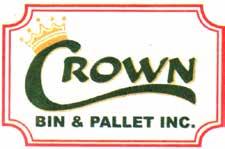

Please




A30 - NORFOLK FARMS - SPRING 2024
We hope your Harvest is going well.
are still taking orders for the fall season.
We
contact us. Office: 519-599-1224 Mike’s cell: 519-270-1145 mike@crownbin.ca Advice from someone you trust. Life’s brighter under the sun Brent McKay*, B.A. CFP® McKay Insurance & Financial Services Inc. Simcoe: 519-426-4595 Delhi: 519-582-1401 brent.mckay@sunlife.com sunlife.ca/brent.mckay 23 Peel Street, Simcoe, ON N3Y 1S1 237 Main Street, Delhi, ON N4B 2M4 *Mutual fund business is done with your advisor through Sun Life Financial Investment Services (Canada) Inc. Advisors and their corporations conduct insurance business through Sun Life Financial Distributors (Canada) Inc. Sun Life Assurance Company of Canada is the insurer and is a member of the Sun Life group of companies. © Sun Life Assurance Company of Canada, 2024.
do not hesitate to
Saying goodbye to real estate

After a long and successful career in real estate one well known local Realtor decided it was time to retire. As of March 1st. Waterford resident Brian Holden made the decision to move on to the next stage of life…sit back and enjoy his free time. “Overall, I had a very satisfactory career in Real Estate. I went ten years after my retirement because I liked what I was doing so much” adds Holden.
Holden began his career in 1988 with another local realtor, Keith Rainey. He worked with Rainey until 1990 when he made the move to Remax Erie Shores Realty Inc. in Simcoe. He became owner in 1995 and remained owner until the sale of the office, in 2018, to two fellow local realtors. “I was full Owner, Manager and Broker of Record in Simcoe”. The Simcoe office remains open and continues to grow and excel. “After the sale of the Simcoe office I was a little bit lost. I thought it would be beneficial to go to a new office and joined ReMax Twin City Realtor Inc., Brantford. I grew up with computers in the real estate business so I was able to work from home across the province. “.
While ReMax Twin City Realtor Inc. is still operating and doing great Holden has officially retired. “It was a wonderful place to end my career. I do miss the interaction…It was a learning experience. It gave me lots of flexibility and I just had myself to worry about” adds Holden.
Holden saw many changes in the market over his years, particularly in farming sales. “Norfolk County is the ‘Bread Basket’ of the province. We have excellent lands and an early Spring for many crops like Ginseng, tobacco and vegetables in general. I saw the growth of the value of the farms and tobacco was regarded as ‘the’ crop for making money”. Holden added “There was a big decrease over the years though with all of the anti-smoking campaigns. The Government got involved with helping growers convert to other crops and Ginseng became the choice for so many.”
“In the early 90’s you could buy an average size Ginseng farm of 75 to 100 acres for about $2,000 to $2,500 per acre. When I left it was about $23,000 to $28,000 per acre. Now it’s well over one million plus and that’s just for the land…no buildings” adds Holden. “Many farms went from Mom and Dad to Son or Daughter operations”.
“My involvement with farm sales was limited. I was a ‘fringe player’ when it came to farm sales. During the last 5 years I became cognizant of farm sales and prices and how the prices kept going up. It’s difficult to market a farm…the last 1 ½ years have been a tremendous eye opener because of the prices”. Holden added “ We’re still not the highest prices for farms in Ontario. For example, Chatham and West of London are mostly corn and bean and their prices are higher than ours”.
As we sat around his dining room table Holden he added “Overall, I had a very satisfactory career. I built my business on referrals…Somebody has to say you’re a good agent and past clients have always been so supportive.”
While Holden has retired to relax and enjoy more time with family there may be a chance…just a tiny chance…he may dabble a bit in real estate but that choice is entirely up to him. Good Luck Brian in your retirement and enjoy the years ahead.
















NORFOLK FARMS - SPRING 2024 - A31 We Know Norfolk Dean Morrison (519) 909-0340 Karen Feth (519) 718-3384 410-7676 Cher y l Rap ai 226 -9 70 -2 49 0 Br oker o f Rec or d D e an Morr i s on We Know Norfolk Dean Morrison (519) 909-0340 Karen 718-3384 Matt DeVos (51 519-9 09- 0 3 4 0 S al e s Repr e s en t at i v e Rob VanP ar y s 519-9 8 3 - 0 88 8 C onnor L an don 519-718 -2 959 D e anna Mitchell 519-2 4 2-7 8 55 S al e s Repr e s en t at i v e Josh Manar y 519-9 8 3 - 0 37 7 S al e s Repr e s en t at i v e S al e s Repr e s en t a t i v e Ros e Rav in 519-9 8 3 - 6281 Br oker S al e s Repr e s en t at i v e ww w.morr isonrealt y.c a FO R B U Y I N G A N D S E LL I N G FA R M S PL E A SE C A L L 1696 W indham Rd. 9, W indham C entre 519- 4 4 3-7352 Rural property features Stone front farmhouse wth rustic beams & trim, open kitchen, dining, and living room 4 beds and 2 baths, finished bsmnt wth wood fireplace Multiple outbuildings, barn, & wooded area with trails, and an irrigation/fish pond. Nearby towns are Simcoe, Delhi, Turkey Point, and Port Rowan. $1,799,900 MLS-40453917 & 40453517 44 ACRES - 24 WORKABLE WITH CHARMING RUSTIC FARMHOUSE 55 Brock St E T llsonburg ON 11 Main St W Norwich ON S e r v i n g O x f o r d , N o r f o l k , E l g i n a n d B r a n t C o u n t i e s F O R A L L Y O U R F A R M R E A L E S T A T E N E E D S ! ROB KOPPERT Broker of Record/Owner 519-532-4355 B T 519-550-7033 rkoppert@royal epage ca brandon-koppert@royallepage ca “ Your local trusted farm Realtor ” SALES REPRESENTATIVE BILL BOUW C 519.427.4820 b.bouw@hotmail com IT ’S RIGHT HERE® “Bo Knows Real Estate ” FOR YOUR FARM REAL ESTATE NEEDS CALL BILL BOUW
Brian Holden and his wife Diane.

A32 - NORFOLK FARMS - SPRING 2024
NORFOLK COUNTY - ONTARIO’S GARDEN
Cleaver Orchards
What began as a modest 18 acre orchard featuring Snow and Baldwin apples has expanded over four generations to 130 acres of fruit production. Most of this acreage is planted with apples, with about ten acres reserved for Bartlett, Bosc and Clapp pears.
Tom Cleaver established the orchard in 1915; son Jim worked with his dad to become one of the largest growers in Ontario. Tom and Jim were both active with the Norfolk Fruit Growers Association, both at times holding the position of President in the association.
Jim’s son Richard was instrumental in starting many new varieties in the 90’s –
including some unique varieties not easily found elsewhere. These additions sparked son Casey’s passion for orcharding. “I just live for this,” Casey grinned, adding, “The connection to the soil, trees … that’s where it’s at for me.”
About 85% of the apple crop, consisting of Gala, Ambrosia and Honey Crisp is marketed through the Norfolk Fruit Grower’s Association with the remaining 15% sold at their retail location on Blue Line Rd. The retail part started with Richard selling bushels of apples on the front yard.
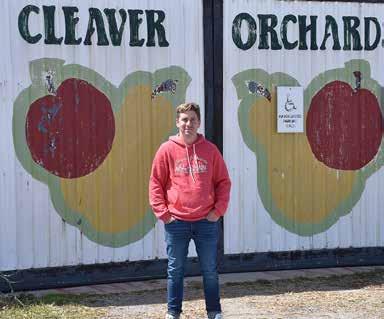


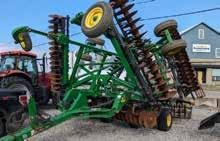
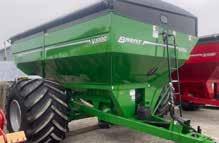
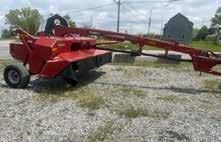


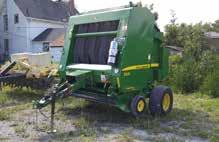





NORFOLK FARMS - SPRING 2024 - A33 4 SEASONS FARM SHOP B6 ONTARIO FOOD TERMINAL B12 SECTION B / ISSUE 29 / SPRING 2024
Please turn to page B4 Casey
W.J.HEASLIPLTD. WJHEASLIP.COM|905-779-3467 HAGERSVILLE,ON 2013JD2623VT DISKBLADES22",CATIV HITCHLINK,ROLLING BASKETHARROW $46,500 NEWBrentV1000 Graincartsinstockone green,onered,1250tires, lightandtarpkit,adj.axle CALLFORPRICE CASEIHDC132 MoCo,Oneowner,Rubber CrimpingRolls,Side-Pull, DrawBarHitch $23,500 2020JD1025R 357HRS,60D AUTOCONNECT,120R LOADERWITHBUCKET. $26,900 2008JohnDeere558 MegaWide•SurfaceWrap •5Feet•Baleramp•hiflotationtires•Hydpickup $21,995 2014JD5100E HRS:3001 Cab/MFWD/540PTO/2 Function/Loader $75,900 2015KubotaZ725 447HOURS,25HP,60" Deck,Gas $7,250 2021JD3033R w/LDR&3rdfunc.must seeonly83hoursvery clean.financingavailable $55,900
Cleaver at the home farm.
Giant Vegetable Growers of Ontario – growing skills, relationships through the years
The old saying ‘that if it was easy, everyone would do it’ rings true
Like many of the members of the Giant Vegetable Growers of Ontario club, Kirk Chenier first got his start in the sport of growing giant produce with pumpkins.
“I grew some pumpkins one year, and then I saw that the president (of the club) at the time just lived in Cameron, ON, which isn’t too far; just north of Lindsay, ON,” he said. “I wrote to him, and he sent me some seeds, and then I ended up joining the club from there.”
Chenier has since served twice as the club’s president himself, having just wrapped up his second term in April. He’s also tried his hand at growing a few different kinds of produce over the years, including giant cabbages, watermelon, and corn; currently, he’s focused on giant tomatoes and sunflowers, because he finds them to be less labour intensive than some of the other popular options for giant produce growing.
While overall, it may sound fairly simple and straightforward, growing giant produce is anything but.
“I quickly learned, you have to be able to and want to put the work in,” Chenier said.
“In the beginning of the season, you’re probably spending two hours a week (tending to giant pumpkins).”
However, “In the height of the season, you’re spending about two hours a day.”
Besides being a big time commitment, growing giant produce can have significant financial
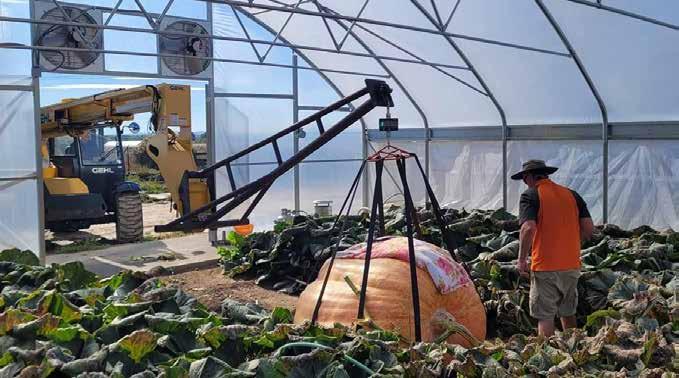
impacts, Chenier said. At the height of their growing season, giant pumpkins can require upwards of 100 gallons of water daily.
“It’s quite a challenge feeding these things,” he said, adding that he knows some of the world record holding giant produce growers have literally spent tens of thousands of dollars to achieve their success.

Record holding growers may use a variety of methods to improve their results. This might include incorporating products like compost, manure, mycorrhizae, liquid seaweed, fish, humic and fulvic acid, and various natural fertilizers, as well as techniques such as growing in a green house, using C02, controlling the vine pattern on the plant and burying the vines, Chenier said.

A34 - NORFOLK FARMS - SPRING 2024
Some giant produce growers will use a variety of techniques and products to help them improve their chances of success. One popular approach is to grow the giant produce in a greenhouse.
If that all sounds like a lot, it is.
“The old saying that if it was easy, everyone would do it rings true.”
That said, Chenier doesn’t want to discourage anyone from growing giant produce if this is something they want to try their hand at – quite the contrary. He strongly encourages anyone who wants to do it to join the club and get connected to its Facebook page, so they can learn the common dos and don’ts from others.
“Then you don’t have to go through that yourself, because we’ve all been there,” he said.
That wealth of collected knowledge is invaluable; club members have proven their skills on the world stage. For instance, Al Eaton, Giant Vegetable Growers of Ontario Hall of Fame member, was the world record holder for longest gourd, measuring in at 173.75 inches, as of time of writing.
There are plenty of growers who are connected to the club and are available for others to draw wisdom from, and the increase in the ubiquitousness of the internet has made it easier than ever to connect, despite distances.
The Ontario club currently sits at 188 members, and while 116 of those are from within the province, 38 hail from across the rest of Canada, 15 are from the U.S.A., and 19 are from Europe. The club’s Facebook page also has hundreds of followers from across the globe.
Each year, club members who have paid their annual dues receive three newsletters by email, as well as a package of various seeds sent in by members.
This is particularly beneficial for anyone wanting to improve their growth results, because “Genetics have always played a large role in the improvement of weights,” Chenier said.
When it comes to growing giant produce, Chenier said there can
be a strong temptation to focus on whether or not you can outdo other growers.
“A lot of new growers, they might grow a 500 or 600 pound pumpkin, but they’re afraid to take it to a weigh in, because it’s small compared to the winner, but it doesn’t matter. That’s their hard work, and they should show it off,” he said. “I’ve always said, the competition is with yourself, and trying to set a new personal best.”
This is a mentality the club also encourages; through its sanctioned weigh ins throughout the year, it awards prizes for the largest produce, but also for the growers with the largest personal gains on their previous weigh ins.
Even if you don’t go home with an official prize, you still might get accolades regardless, Chenier said. He noted that there have been plenty of times when he’s been on his way to or from a weigh in, and while driving on the highway or when at a rest stop, other travellers have offered thumbs ups, high fives, and other praise for his accomplishment – it’s not every day people see a pumpkin that might be bigger than themselves, after all.
It’s not just when there’s a weigh in that giant produce growing is a personally rewarding experience, either.
“It’s nice to be outside and be one with nature. I think more people need that these days, because everybody’s got their face stuck in their phone or computer and stuff like that – myself included,” Chenier said.
He noted that as a grower, you might see things you never would have been able to witness otherwise. For instance, one year, he was trying to address an insect problem in his
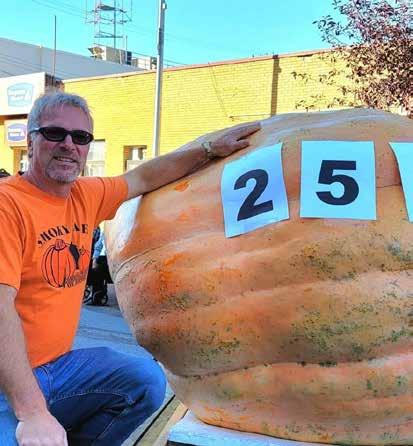

garden, so he brought in some praying mantis eggs.
“I was lucky to catch one that was hatching, and it was one of the most amazing things I’ve ever seen,” Chenier said.
Growing giant produce can also be a way to grow relationships.
“It definitely is something that families can work on together,” Chenier said. “We’ve had a lot of members who were interested from the time they were like five or six.”
While their interests might shift as they get older, it’s still a great
way for kids to make memories with their parents, grandparents, etc.
For Chenier, the thing that’s always appealed to him with growing giant produce is the challenge of it all.
“(You) take a little seed … and it grows into this great big thing.”
For more information about the club, visit gvgo.ca. Chenier also recommends those who are specifically interested in trying their hand at growing giant pumpkins visit bigpumpkins.com for more information, tips and tricks.

NORFOLK FARMS - SPRING 2024 - A35
DRILLED WELLS PUMP SYSTEMS BORED WELLS WATER GUARANTEED You see our signs everywhere TIME TO FIND OUT WHY! Call us FIRST for great deals on new wells & pump systems LUCAN 519-227-0057 1-888-535-4455 www.haydenwaterwells.com info@haydenwaterwells.com Like us on Facebook Hayden Water Wells - Follow us on Instagram @haydenwaterwells OR JUST ASK OUR SATISFIED CUSTOMERS! Hayden Water Wells_Layout 1 2023-12-13 9:00 AM Page 1
As of time of writing, Don Crews is the Canadian giant pumpkin record holder for his mighty gourd, weighing in at 2,537 pounds.
Pat Watson is a member of the Giant Vegetable Growers of Ontario, and has been recognized for his horticultural success with raising giant produce.
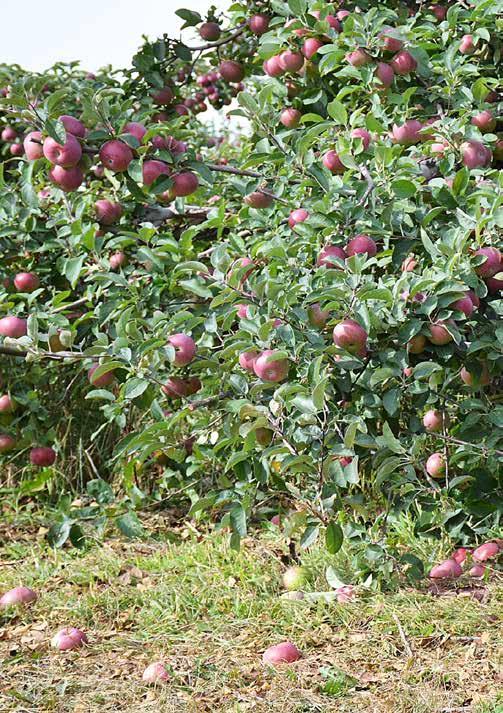
from late August to the end of October. Favourite varieties for their customers include: Ginger Gold, Silken, Gala, Ambrosia, Honey Crisp. Aurora Golden Gala and Evercrisp. Older varieties like Macintosh, Red and Golden Delicious are also available. In addition customers can delight in heritage varieties like Snow, Tydeman, Tolman Sweets, Northern Spy and Golden Russet. One interesting new variety is Hidden Rose, a green skinned apple with red
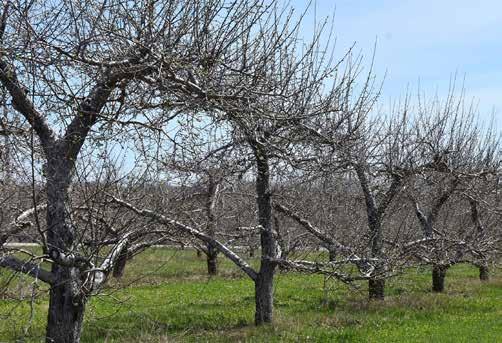

flesh. These are ready just in time for the Norfolk County Fair.
Apples are a long-term project. In year one planting occurs with 1000 to 2000 trees per acre. Yong trees are now planted on trellises, which give support and produce a better, more uniform quality of fruit, due to all getting a consistent amount of sunlight. The trees are pruned for height and width, making for a higher volume of quality fruit and making harvesting much more efficient.

Harvest starts in late summer. A 15 man crew from Jamaica arrives mid August and stays till November 10th. Some of these men have come to this same farm for 35 + years and are like family to the Cleavers.
Some of their customers also feel like extended family, as they return year after year to the retail store. Casey noted, “I think it’s really neat,” to see kids come, grow up and then bring their own families to the store.
Casey, brother Cody and dad Richard do the bulk of the work for the orchard, jobs like spraying and pruning, as well as maintaining the machines (Cody’s part). Casey’s wife Sarah will soon be taking on the responsibility for managing the office work. Casey identified the biggest challenge for his job is deciding which varieties to keep. New trees start producing at three to four years and reach peak production by year nine. Productive life is about twenty five years.
Weather is also a huge challenge, with dramatic ups and downs. 2012 and 2015 saw complete crop losses. 2016 saw a high volume of fruit after the lost year, but a drought resulted in small size.
Casey identified big rewards too. Mainly the satisfaction of maintaining a family business, carrying on great grandfather Tom’s enterprise on the same property. Casey very much appreciates his ability to spend time with his dad on the farm. “I have a ton of respect for the three that came before me,” he stated, adding that he hopes his children will continue the business into the future.
As to that future, Casey wants to continue with new varieties, using sustainable practices with a focus on soil health.
A36 - NORFOLK FARMS - SPRING 2024
Ripe apples in the Cleaver orchard along the Blue Line.
Old trees near the retail location. These trees are about thirty five years old.
Young trees growing on a trellis near the retail location.
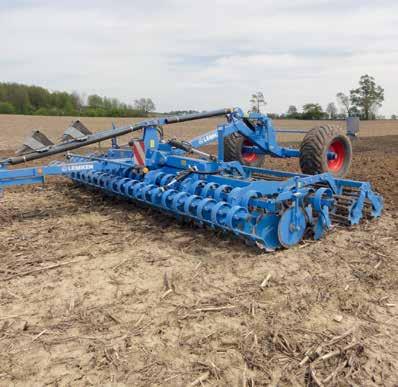


BURGESSVILLE - 519.424.9374
MILVERTON - 519.603.8374
YOUR PARTNER FOR NEXT LEVEL FARMING
LEMKEN offers a wide range of High Speed Discs like the Heliodor 9 to handle serious problems like baked, crusted, rutted or wet fields, heavy trash, fungicide resistant diseases, and herbicide resistant weeds on your farm.
LEMKEN CropCare intelligent mechanical weeders, like the EC-Weeder, provide farmers with automated, pesticide-free weeding options for vegetable and organic crops. The EC-Weeder is fully customizable with many interchangeable attachments and an optional IC-Light steering system that ensures effective weeding within 2 cm of the crop at up to 15 km/hr.
South African made Equalizer CII Planters are Precision Seed Planting Units for No-Till or Conventional Tillage systems and are now available in Canada. They come with a factory-installed triple tank system for onboard liquid and/or dry fertilizer and/or seed. Equalizer Planters give you the option to delivery your inputs where you want. Our unique gauge wheels float over wet spots and deal with sandy soil better too.
NORFOLK FARMS - SPRING 2024 - A37
Heliodor
EC-Weeder
Equalizer CII planter
A store for all seasons
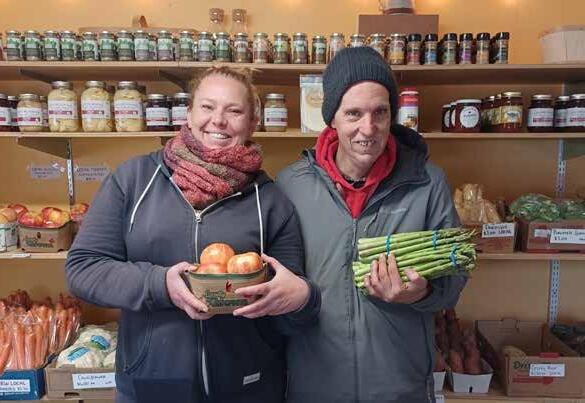

From Winter to Spring, Summer and Fall there is a one-stop shop that offers a great variety of some of the yummiest fresh fruits, vegetables, preserves, homemade goodies… something sure to tease your taste buds.
When Danny den Baars and Cynthia van Ede first opened their 4 Seasons Farm Shop in Simcoe they started with just one table. They soon realized that one was not enough so a second table was added. Word soon spread that their produce and other products were some of the best in the Simcoe area, their customer base grew and so expansion was needed… once again. In Oct. of 2015 they erected a building on their Simcoe property to remain open year round and increased the selection of goods available.
Their fresh produce selection, at present, offers a large variety of veggies such as asparagus, broccoli, celery, all types of cabbage, carrots, onions, cauliflower… the list is long and always changing (depending on availability). “Starting in May we will have fresh asparagus” adds Cynthia.
“We have a small greenhouse for seedling plants such as tomatoes, sweet bell and hot
peppers, lettuce, zucchini, cukes…just to name a few. We also offer, in season, cherry, grape, heirloom, small yellow and green tomatoes. We have a very good variety to offer customers and are always trying to find what others might not have like sweetheart cabbage (from a local grower).”. But their selection doesn’t stop there. “We grow rhubarb and raspberries and we are going to try melons this year… small sized, European melons…They are so much better tasting” states Cynthia. “We strive to have as much local produce as possible. In the summer almost everything is local. In winter we add non local so we still have a nice assortment of produce”.
Their year-round offerings, in store, include a great selection and variety of locally sourced out preserves, baked goods, perogies…the list goes on. “We get our perogies from St. Jacob’s and have eight varieties and our preserves are from Mennonites as well…Country Flavour, Golden Harvest, Auntie’s Grove, and Kountry Kitchen Cupboard. Our maple syrup comes from Hayes Maple Syrup in Tillsonburg and our honey is from Mt. Elgin. We go out, buy their products, try them and, if we like them and the
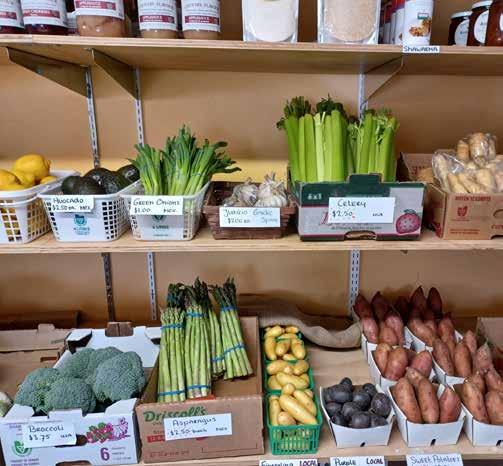
price is right, we bring them into our store. We also carry a few Dutch items from Double Dutch and Schep’s Bakeries in Norwich as well as ‘goodies’ from My Sweet World in Hagersville.” adds Cynthia. “We also carry three flavours of strudel, tarts and waffles”.
“We are always sourcing out new ideas… we just figure it out as we go. In the Summer we are going to offer small herb pots and are going to be adding some more succulents. It’s kind of a side hobby but now we are going to do it on a little bigger scale”. From what I could see on my visit to their store it holds so much more than it would appear from the outside so you really have to go and check them out for yourself. The amount of foot traffic and sales in the time I was there is evidence of the quality of their products and their faithful returning customers who, by the way, had nothing but praise for their goods.
4 Seasons Farm Shop is located at 691 Norfolk St. South, Simcoe. Because their hours depend on product availability you can check them out on Google or Facebook. Cynthia keeps them up to date.
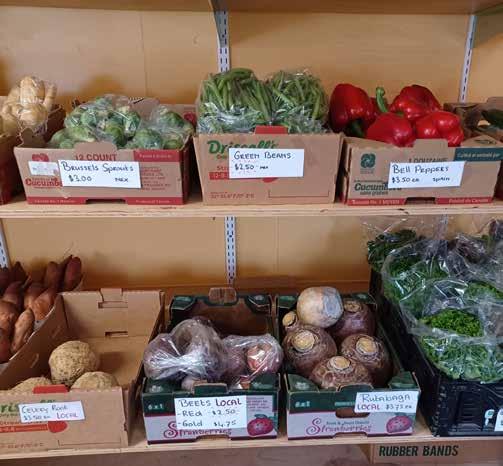
A38 - NORFOLK FARMS - SPRING 2024
Owners Cynthia van Ede and Danny den Baars
sampling of their products available A sampling of their products available
A sampling of their products available A
The best strawberries, available near you
A new, innovative way of growing strawberries has turned into a retirement venture for a Norfolk County farmer and produced what he believes are the largest, tastiest, juiciest berries.
Mark VanGoethem, who is widely known in his role working for Gentec selling drip irrigation the past 20 years, recently retired from that role and was looking for something else to do. He had found the ideal property, 28 acres on Rhineland Road, but needed the crop to fit the property.
VanGoethem grew up on the family farm, which his grandfather started, on the edge of Waterford. Originally a tobacco farm, a transition to horticulture took place when tobacco slowed. He grew peppers, tomatoes, potatoes, sweet corn – literally everything except strawberries.
“I started going to the food terminal when I was 17 for my dad,” he recounted. “Then, when I went on my own, I was still doing the food terminal.”
When the opportunity came to work for Gentec, VanGoethem slowed down on the farming side, growing pumpkins and renting out the remainder of the land. He said pumpkins meshed well with his agriculture sales job as harvest was in the fall when he wasn’t as busy.
Then when he made the move to Rhineland Road, he started operation as VanGo Farms with one acre of strawberries.
Past experiences prepared VanGoethem for the marketing aspect of selling the strawberry crop. Admitting he didn’t know anything about growing strawberries, he hired an agronomist to advice on growing the crop, which he said was a good decision.
Although table top strawberries give the vision of strawberries grown at waist level, this set up is actually at chest level. The strawberries are grown on a special infrastructure that holds trays


at chest level, with a plastic dome to diffuse the light above the plants. The trays have dirt and are watered through a drip system with fertilizer.
“It’s unique, it’s relatively new in Canada,” VanGoethem said, adding the system is expensive to install. It’s also labour intensive and he has temporary foreign workers assisting him.
The strawberries aren’t organic as some pesticides are used, but most of the pest control is through beneficial bugs. He described this system as bugs that will eat mites, similar to lady bugs.
“You put them throughout the garden,” he said. “They eat the mites and whatever other bugs are a problem for the berries. If the beneficials don’t keep up, we go in and spray then introduce the good (bugs) again.”
The first year he sold some strawberries through a wholesaler and some direct to retailers. The reaction from retailers was so great, he will stick to direct wholesaling.
“Last year when I went and sold these, no one said ‘No’ to me,” he said. “I got guys calling me already this year.”
There will also be the new roadside stand, where both pre-picked and pick-your-own will be offered. VanGoethem is putting in another acre to prepare enough product for the roadside stand. He believes the berries will sell themselves.
“They’re bigger, they’re brighter, they’re sweeter and they’re firmer,” he said. “Everything about them is better.”
VanGo Farms usually has strawberries from May or June to October or November, dependent on the weather.

NORFOLK FARMS - SPRING 2024 - A39
Mark VanGoethem checks out the progress of the strawberry plants on his farm on Rhineland Road. Although this photo was taken in mid-April, there were already strawberries in bloom. Usually berries are available May or June, dependent on the weather.
Johnnyseeds.com | 1-877-564-6697 | #growwithjohnnys 100% Satisfaction Guarantee Non-GMO Safe Seed Pledge 100% Employee Owned We’re here to support you from seed to harvest with quality seeds, tools, and growing information! Visit our Grower’s Library, which offers key growing information for every crop, how-to videos, calculators, growing guides, and more. Johnnyseeds.com
The table top strawberries grown by VanGo Farms are bigger, better and tastier. This year the operation on Rhineland Road is going to expand to include a roadside stand to purchase berries as well as pick-you-own.
Rhubarb: A plant & pie, for every season
Rhubarb (Rheum rhabarbarum), aka ‘pie plant’, was once a staple in Ontario homes and gardens since Colonial Times. Most everyone had a plant or two just outside the back door, or in a nearby garden. However -presently, and in Canada, there is a mere and meager per capita consumption of 0.1 lb! ...and down 88% from it’s ‘heyday’ during the 1920’s, 30’s, and 40’s. Therefore, there is likely some opportunity for enterprising growers to take advantage of this low rate of consumer consumption, here in Canada.
Rhubarb is native to southern Siberia, and the ancient Chinese used it as a medicinal herb
toxic amounts of oxalic acid and are poisonous. The ensuing cramps, nausea, and sometimes death from ingestion, ‘suppressed’ interest in the plant for about 200 years! But by the late 18th century, Europeans had discovered that the tart stalks were the part to eat, perfect for ‘tarts’ ...giving rise to the nickname ‘pie plant’.
Bill and Diane French and now with son, Brian, are continuing a 120-year old tradition, of rhubarb production on the family farm (Lennox Farms) in Melancthon, Ontario (halfway between Orangeville and Collingwood). Supplying about 80% of the Ontario market with rhubarb, they are the largest grower in Canada with about 90 acres in production, and among the top producers in all of North America. Rhubarb was initially established on the French farm as a forcing crop. In earlier years, fresh produce could only be had seasonally, therefore forced

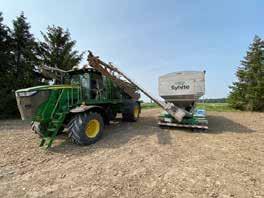
rhubarb was considered to be a welcome ‘treat’ in the dead of winter.
Although there are many rhubarb varieties to consider, the French family after many years of trial, have selected Victoria, Sutton Seedless, and German Wine, as ‘tried-and-true’, to their needs. In the beginning (on the French family farm), rhubarb was mainly produced for forcing, then expanded into processing (pie-fill, jams and preserves), and then of course, for the fresh-market supplying the larger urban centres. In early years, nearly everyone had a few plants to supply their domestic needs, however, with apartment-style living, etc., where gardens are no longer possible, for most people.

Now, the bulk of rhubarb production (6070%) on the French farm is destined for the fresh-market, and the French family have their own stall at the Toronto Food Terminal. In addition, they sell through Bayshore Shippers of Burlington, whereby many stores are supplied with a 1-pound pak, usually containing 8 stems on a tray, all wrapped in cellophane. German Wine is the main variety used for fresh-market production, as it yields well, and has both good external and internal red colour extending half-way to two-thirds into the interior of the stem (botanically, the leaf stem is known as a petiole, just as is the celery stalk). This variety is somewhat less ‘stringy’, has good flavour and not as tart as some others. And is usually the case, fresh-market sales have a higher profit margin than that for processing.
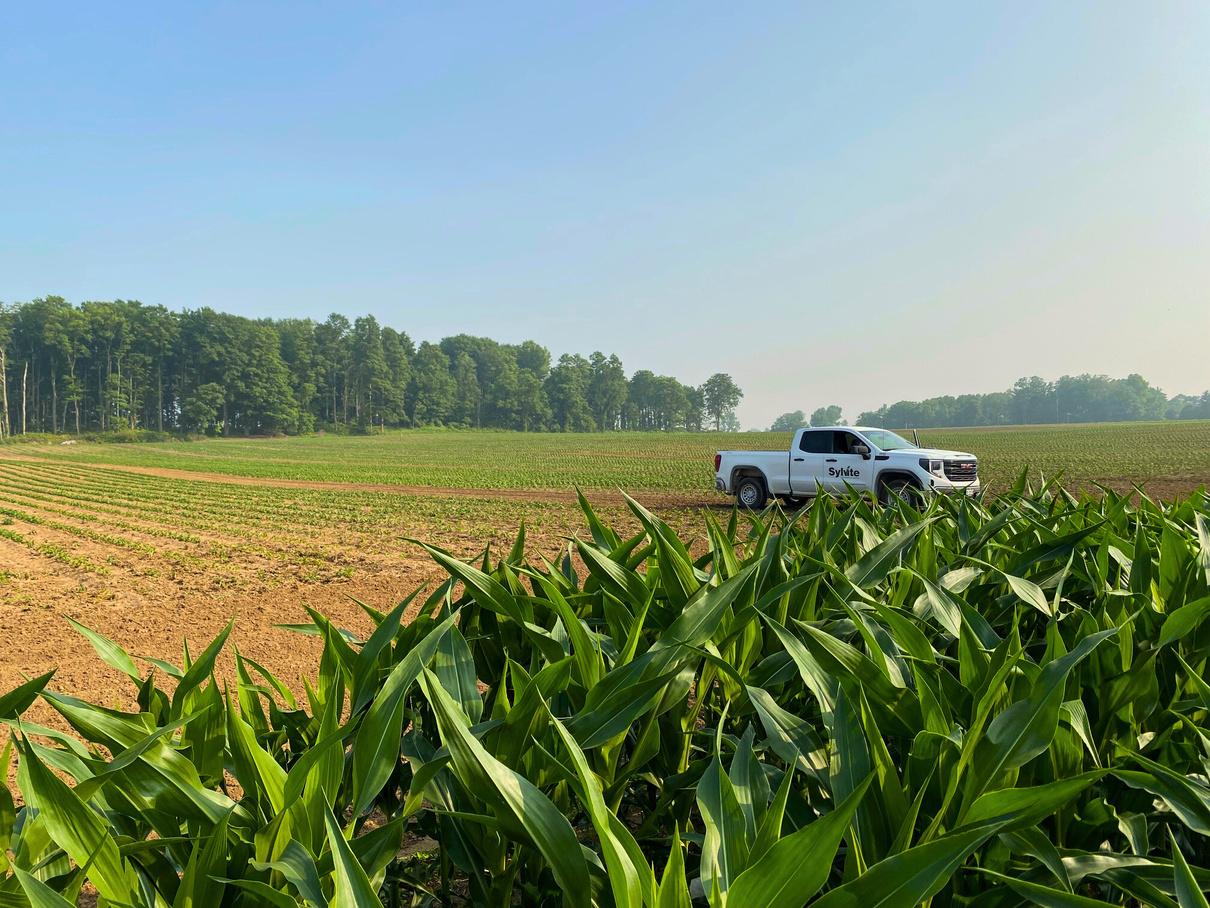


While harvest will begin mid to late May, the main harvest is in June and continues into the first week of July. Approximately, 80% of the stems of the crop are harvested, giving yields of 8,000-10,000 lbs/ acre. The crop will produce for a duration of about 12-15 years, but harvest is only in alternate years ...allowing for the crop to ‘rest’, in the ‘off’ years. If it is a wet year, and rainfall is regular, harvest can continue for the entire growing season, as the crop will continue to produce leaves.
Rhubarb juice is a newer product line these past 3-4 years for the French family, and about 40,000 lbs is pressed every season. The juice is used in alcoholic beverages such as rhubarb-apple cider, and also sold fresh to wineries. Among other products for sale on the home farm, the French family mixes rhubarb

A40 - NORFOLK FARMS - SPRING 2024
premier choice for all crop inputs. GENERAL@SYLVITE CA SYLVITE CA CROP PROTECTION | FERTILIZER | SEED | CUSTOM APPLICATIONS AGRONOMY | CROP SCOUTING | SOIL SAMPLING | TILE DRAINAGE NORWICH 77310 HIGHWAY 59 S NORWICH 519-727-2201 SILVERHILL 1605 FORESTRY FARM RD LANGTON 519-727-2600 WILSONVILLE 461 CON 3 TOWNSEND WILSONVILLE 519-443-8635
Your
PERFECT FROM PLANTING TO PLATTER
Look no further than Luna® fungicides to keep your horticulture crops producing their best. Luna’s two modes of action make for a wide disease spectrum - coupled with a broad crop label, that means high quality and high yields for you. Get the best out of your crop with Luna. Learn more at cropscience.bayer.ca/Luna
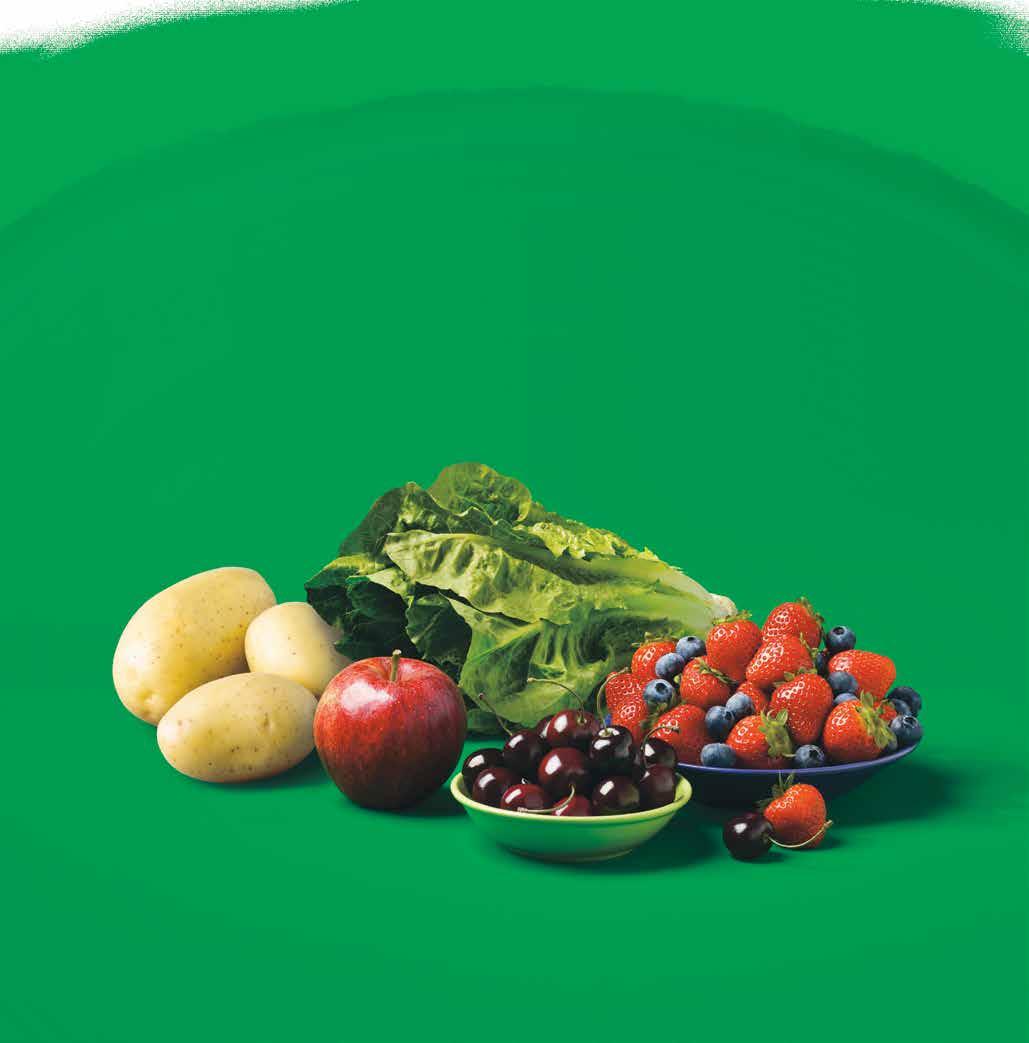

NORFOLK FARMS - SPRING 2024 - A41 PR20250 Luna Ad Norfolk Farms Newsletter.indd T:10.25"
Always read and follow label directions. Bayer, Bayer Cross, Luna®, Luna Sensation® and Luna Tranquility® are registered trademarks of the Bayer Group. Bayer CropScience Inc. is a member of CropLife Canada. ©2024 Bayer Group. All rights reserved.
T:14.25"
cropscience.bayer.ca | 1 888-283-6847 | @Bayer4Crop sCA


juice with cane sugar, and makes for a very refreshing summer drink!
Winter-forcing of rhubarb spreads out the production season. Crowns that are 2 years of age are lifted from the field and put into forcing sheds in the fall of the year (older crowns are too big and heavy to move about efficiently). Each shed is designed to hold 5,000 crowns packed tightly together and can yield between 8,000-10,000 lbs. However, since rhubarb is a perennial crop, it requires a minimum of 50 days at 5°C (cold temperature requirement) to break its winter dormancy. Once in the forcing shed, and to maintain the best colour, plants are kept in total darkness, and grown (forced) at 10°C. A heat exchanger is used to reduce humidity. Earlier forcings can take up to 8 weeks to get a crop, while later season forcings can be cropped in 3 weeks.
Apart from the rhubarb foliage, which is toxic, nothing is wasted. Even the pulp left-over from pressing, is dried and made into flour ...albeit, still in the experimental stages. Rhubarb flour has the advantage of being gluten free, with potentially many uses.
As a matter of interest, the village of Shedden (west of St. Thomas) has being hosting the annual Rosy Rhubarb Festival for the last 30 years featuring rhubarb (of course), and always during the weekend of June just prior to Father’s Day. While you may have missed it this year, mark your calendars, for next! Truly, rhubarb is a plant and pie, for every season and for every reason!
As a biostimulant product, Megafol® is formulated with plant extracts that are critical to productivity and plant stress-response. Although Megafol may not prevent plants from showing symptoms of abiotic stress, like frost, it can help your crops recover quicker by increasing natural plant responses five to eight times more than those that do not receive an application.1 This leaves your crop ready for whatever comes next.
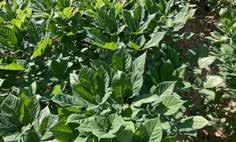
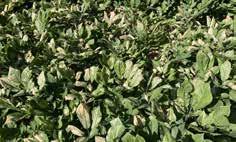




A42 - NORFOLK FARMS - SPRING 2024
1Source: Research trials conducted at Joint Lab Valagro @ PlantLab – Sant’Anna School of Advanced Studies in Pisa, Italy. Performance evaluations are based on internal trials, field observations and/or public information. Data from multiple locations and years should be consulted whenever possible. Individual results may vary depending on local growing, soil, and weather conditions. For more information, contact our Customer Interaction Centre at 1-87-SYNGENTA (1-877-964-3682), or follow us on Social Media @SyngentaCanada Always read and follow label directions. The Alliance Frame, the Purpose Icon and the Syngenta logo are trademarks of a Syngenta Group Company. Megfol® is a registered trademark of VALAGRO S.p.A. © 2024 Syngenta.
Assist with stress and encourage growth with Megafol. Megafol applied @ 1 L/ac twice over the previous 30 days Grower’s standard stress management program Photos taken in Norfolk County, Ontario, in 2021. Megafol applied twice for cold temperature management, results shown were observed 30 days after the last application when direct sunlight stress occurred. Scan the QR code to learn more about Megafol norfolkfarmsnews.ca norfolkfarmsnews.ca/advertiseScan the QR code and visit us online

LOTS OF OPTIONS. ONE DESTINATION TO HIGH-QUALITY FRUIT AND VEGETABLE CROPS.
This season, give your high-value fruit and vegetable crops the best start and protection they deserve with products from FMC.
Proven insect protection - Protect your crops from yield and quality damaging pests such as western bean cutworm, leafrollers, leafminers, aphids, cutworms, armyworms and more with one of our proven insect control products.
































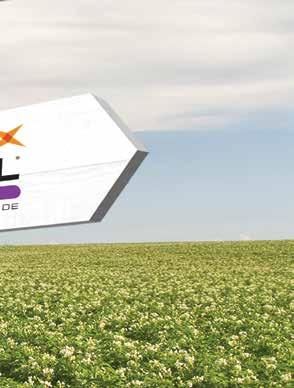

NORFOLK FARMS - SPRING 2024 - A43 Always read and follow label instructions. Member of CropLife Canada. FMC, the FMC Logo, Altacor, Coragen, Exirel, Pounce and Verimark are trademarks of FMC Corporation or an affiliate. Beleaf is a trademark of Ishihara Sangyo Kaisha, Ltd. ©2024 FMC Corporation. All rights reserved. 7718 01/24 See our full portfolio
7718 Fruit and Vegetable Portfolio Print Ad_NORFOLK FARMS.indd 1 2024-03-18 3:12 PM
Spring flowers followed by showers of fresh, local Ontario produce at Ontario Food Terminal


Colourful spring flowers are the forerunners for nutritious ‘showers’ of fresh, local Ontario fruit and produce at the Ontario Food Terminal (OFT) in Etobicoke.
The terminal operates year-round, hosting between 200 and 250 active farmers including winter-season growers, including for example, Den Boer Farms of Otterville or greenhouse tomato producers from the Leamington area. However, early-spring flower production has been a growing trend says OFT General Manager, Secretary Treasurer Bruce Nicholas.
Florals typically begin to arrive in mid and later April, he continued, in advance of asparagus’ May onset.
“And then the veggie guys start to take over through until October or November.”
The two are related by more than timing says Nicholas, with an increasing number of vegetable farmers adding flowers to production to provide an early cash infusion supporting their original horticultural crops’ production.
“So it works out quite well.”
OFT evolution is part of its operational position as arguably the most productive 40-acre agri-business-related property in the province. Five-point-six million pounds of fruits, vegetables and produce are distributed through its environs daily, 2.1-billion pounds annually. That impressive total could be multiplied by a factor of two or three when related direct-sales deliveries are considered.
“Those numbers are hard to quantify,” said Nicholas, although the terminal’s overall status amongst its peers is easier to define. “It’s probably top three in North America.”
The terminal is owned and operated under the Ontario Food Terminal Board,

a self-funded (through fees) board-governed provincial agency under the Ontario Ministry of Agriculture, Food and Rural Affairs. Employing a staff of 48, it provides direct connection between producers - including roughly 40 from Norfolk County who take advantage of the OFT - and over 5,000 buyers. Products passing through the OFT end up
4800 SMALL WHEAT BALES FOR SALE

A44 - NORFOLK FARMS - SPRING 2024
Over two billion pounds of food passes through the Ontario Food Terminal annually.
Fresh produce farmers adding early florals to their line of horticultural products is a growing trend, says Ontario Food Terminal General Manager, Secretary Treasurer Bruce Nicholas.
Spring flowers are the precursor to ‘showers’ of fresh, Ontario produce at the Ontario Food Terminal.
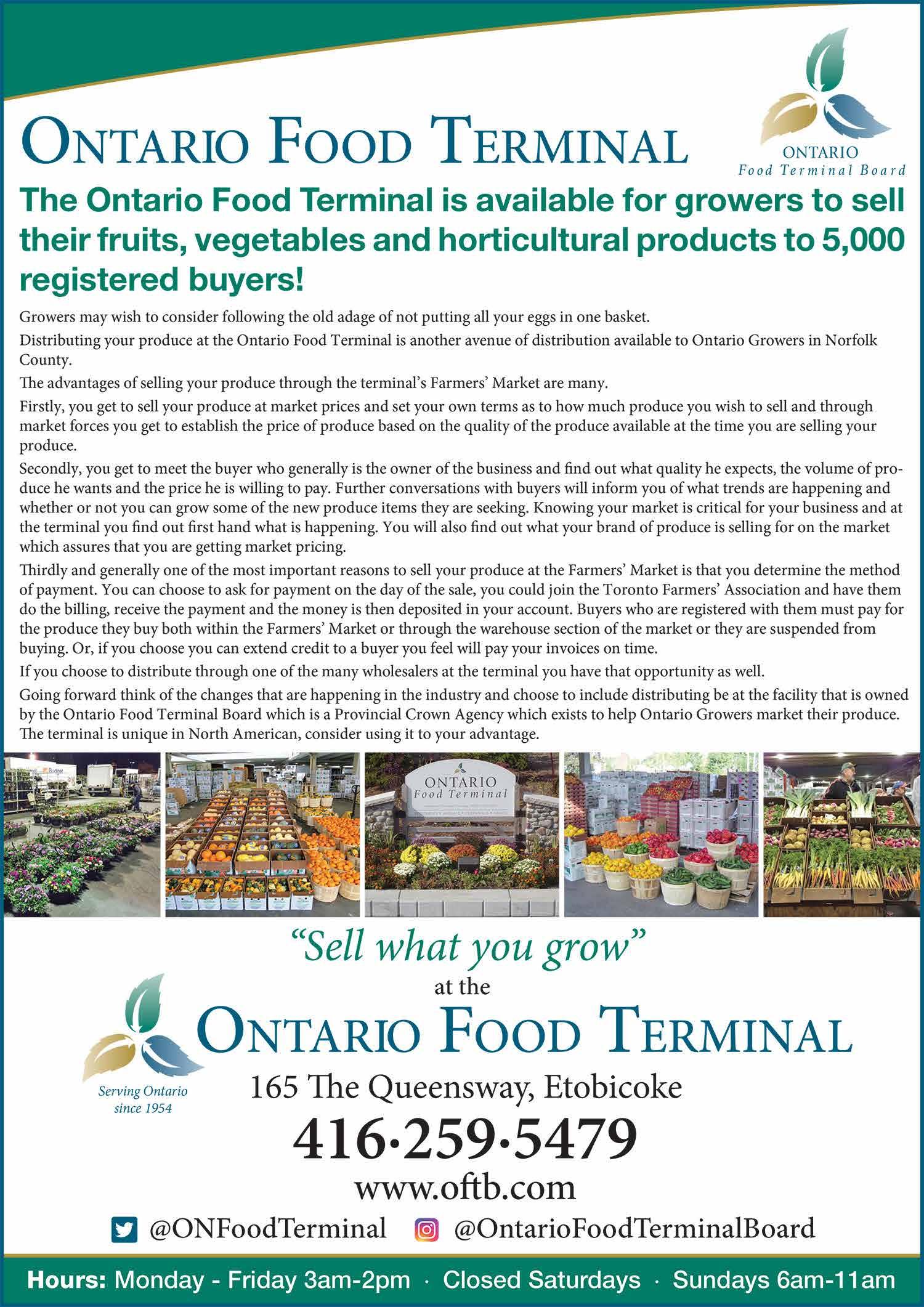
NORFOLK FARMS - SPRING 2024 - A45
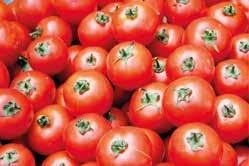
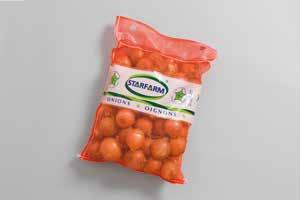




in destinations throughout Ontario and coast to coast from Newfoundland to Vancouver.

NNZ offers a broad portfolio of retail packaging materials for fresh produce.
+1-519-863-5782
F:+1-519-863-5784
+1-778-819-1139 west@nnz.ca
F:+1-519-863-5784
RUPP FEATURE:
Yosemite is a great pumpkin for kidsespecially school groups. Growers love its stunning shape, strong handle, and color.

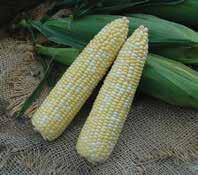
Superb MXR can handle difficult growing seasons.
Large ears and improved husk protection make this 74-day great for mid-season markets.

Matriarch is successful at higher plant populations.
This 78-day Attribute II sweet corn has a surprise. It has superior insect control!
best products in partnership with: IFSI, Syngenta, and Crookham.
More than 1,000 seed varieties at ruppseeds.com
Questions/Orders: 1-800-700-1199

A 76-day
“And depending on price and the U.S. dollar we have guys who send stuff to the States,”
Operationally, it’s a marketplace where producers truck and display their produce for buyers. It is not unusual even at this early phase of the year for 20 or 30 of the latter to be lined up at the OFT’s entrance at 2:30 a.m. waiting for 3 a.m. opening.
“In April,” Nicholas emphasized, noting numbers of buyers and length of their lineups pick up significantly as the growing season advances. “If you are selling something, wouldn’t you like to have a couple thousand people waiting to buy?”
The OFT does offer a crucial option or alternative outside of direct sales to chain stores, believes Nicholas.
“Where you determine what you’re bringing in, what price you’ll accept and meet the needs of the company.”
Its existence plays an important role in helping establish prices based on dynamic market supply and demand, benchmarks applicable and referenced throughout the industry.
“Even if they’re not selling there.”
Timeliness, quality and relationship with buyers are key components to sales. For example, bringing the first loads of fresh, spring asparagus to the terminal is anticipated to result in a premium. Producers are paid within ten days, or alternatively says Nicholas, can request cash up-front on the day.
“And off you go hopefully with an empty truck and money in your pocket.”
It does take time to bring and sell produce through the OFT says Nicholas, however he considers the exercise both instructive and constructive. Beyond building productive relationships with buyers, farmers can also gain insight into market trends, including new products like for example, watermelon radishes.
“That’s what it’s all about.”
In establishing a nationally-scalable hub between Canadian producers and consumers, the terminal also provides a crucial component in national food security unaffected by border restrictions or politics.
“Do you want to be a country that relies on someone else’s food, or do you want to produce it yourself?” Nicholas concluded rhetorically.

June 25, 2024 8:30 - 2:35
Lunch included
Efficient irrigation plays a vital role in Norfolk County’s agricultural community in order to support our diverse range of crops. This field day will cover everything irrigation led by industry professionals. Scan the QR Code to pre-register
 Diamond Mine is one of the best tasting whites available.
sweet corn that produces large ears with excellent tip fill and husk cover.
Diamond Mine is one of the best tasting whites available.
sweet corn that produces large ears with excellent tip fill and husk cover.
DIAMOND MINE SUPERB MXR
MATRIARCH
YOSEMITE
RAISING THE BAR IN QUALITY, FLAVOR, & YIELD The
NEW NEW
"
tast y choi
ging
A
c e of produce pack a
"
www.nnz.ca
info@nnz.ca
136 Main Street West Unit 3, Norwich Ontario, N0J 1P0
NNZ
Canada.
Inc
NNZ Inc. Western Canada
www.nnz.ca Unit 107-2076 192 Street, Surrey BC, V3S 3M3
pa
f r esh NSCIA IRRIGATION DAY
cka gi ng f or
$20 for pre-registration $40 at the door Sandy Shore Farms, 754 Lower Side Road, Port Burwell
Apples are one of the most popular fruits in the world, and for good reason. They are delicious, nutritious, and versatile. There are over 7,500 different varieties of apples grown around the world, each with its own unique flavor, texture, and appearance.
Apples can be broadly classified into two categories: tart apples and sweet apples. Tart apples have a high acid content and a sour flavor. Sweet apples have a low acid content and a sweet flavor. Some apples fall somewhere in the middle of the tart-sweet spectrum, and are often described as being “sweet-tart” or “balanced.”
The image shows a variety of popular apples, arranged in order of tartness from left to right. The most tart apple is the Granny Smith, and the most sweet apple is the Honeycrisp.
Tart apples are often used in baking, as their tartness helps to balance out the sweetness of other ingredients. They are also a popular choice for making cider and other fermented apple products. Some popular tart apple varieties include:
Granny Smith
Pacific Rose McIntosh
Empire
Jazz Braeburn
Lady
Cortland
Jonagold
Sweet apples are often eaten fresh, as their sweetness makes them a delicious and refreshing snack. They are also a good choice for cooking, as they retain their sweetness even when cooked. Some popular sweet apple varieties include:
Apple Varieties
Honeycrisp
Fuji Gala Ambrosia
Golden Delicious
Red Delicious
Sweet-tart apples are a good choice for both eating fresh and cooking. They have a balanced flavor that is not too tart or too sweet. Some popular sweet-tart apple varieties include:
Pink Lady
Envy
Opal
Smitten
Sugarbee
Apples can be used in a variety of ways. They can be eaten fresh, cooked, baked, or juiced. Apples are also a popular ingredient in many different dishes, such as apple pie, apple crisp, apple cider, and applesauce.
Here are some tips for choosing the right apple for your needs:
-If you are looking for an apple to eat fresh, choose a sweet or sweet-tart variety.
-If you are looking for an apple to bake with, choose a tart variety. The tartness of the apple will help to balance out the sweetness of other ingredients in the recipe.
-If you are looking for an apple to make juice with, choose a sweet variety.
-No matter what your preference is, there is sure to be an apple variety out there that you will enjoy.
Additional information:
-Apples are a good source of dietary fiber, vitamin C, and potassium.
-Apples are also a low-calorie food, making them a good choice for people who are trying to lose weight or maintain a healthy weight.
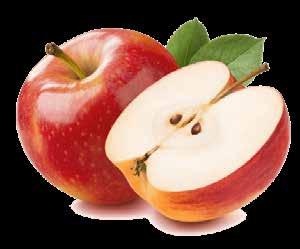
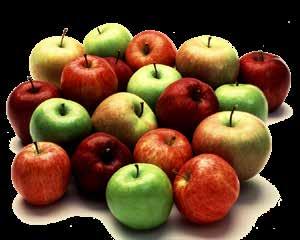
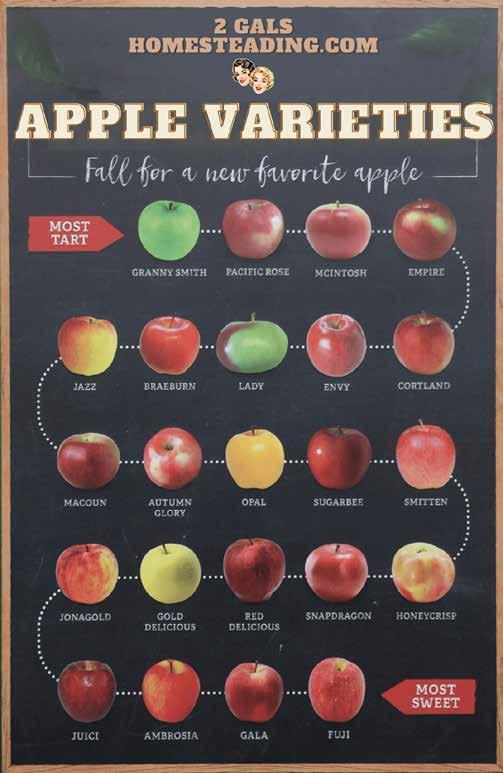
-Apples have been shown to have a number of health benefits, including reducing the risk of heart disease, stroke, and cancer.

Cadman Irrigation Reels are built using high-strength
tested and proven to stand up to the harshest
farming in Ontario has to offer The result
better results and the fastest ROI for any piece of equipment you’ll buy Learn


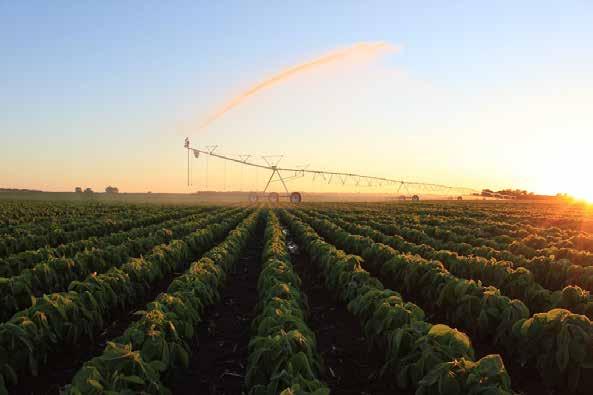
NORFOLK FARMS - SPRING 2024 - A47
Fun fact: The largest apple ever grown was a Granny Smith apple that weighed over 3 pounds!
arm or lateral system Combine it with Variable Rate Irrigation, and you have true precision irrigation with maximum efficiency Put your irrigation to work where and when you need it Contact us today to map out your system I N D U S T R Y - L E A D I N G D U R A B I L I T Y F O R O N T A R I O F A R M I N G N D U S R Y - L E A D I N G U R A B L I T Y F O R O N A R O F A R M I G Reel in success with hose solutions for every field success hose for every field
steel
conditions
higher yields,
more about our entire irrigation line up, CONTACT US TODAY w w w c a d m a n p o w e r c o m ( 5 1 9 ) 6 8 8 - 2 2 2 2 ( 1 9 ) 6 - 2 2 T F : 1 - 8 6 6 - 4 2 2 - 3 6 2 6 T F : 6 - 4 2 2 6 i n q u i r i e s @ c a d m a n p o w e r c o m n q i r i e s a a n p w c m P R E C I S E C O N T R O L . P R E C I S E A P P L I C A T I O N . P R E C I S E C O N T R O L P R E C I S E A P P L I C A T I O N P R E C I S E E F F I C I E N C Y . P R E C I S E E F F I C I E N C Y Y o u r L o c a l R e i n k e P l a t i n u m P l u s C e r t i f i e d R e p r e s e n t a t i v e s : Y o u r L o c a l R e i n k e P l a t i n u m P l u s C e r t i f i e d R e r e s e n t a t i v e s : D u a n e P h i l l i p s : ( 2 2 6 ) 9 7 0 - 1 2 6 5 D u a n e P h i l l i p s : ( 2 6 ) 9 7 0 - 1 2 6 5 A l i c i a B a l b e r m a n : ( 5 1 9 ) 9 8 3 - 2 0 7 9 A l c i a a l b m ( 5 1 9 ) 8 3 - 0 7 0% FINANCING AVAILABLE AND DON’T PAY FOR 6 MONTHS! 0% FINANCING AVAILABLE DON’T PAY FOR 6 MONTHS! *OAC Conditions Apply
Navigator GPS from Reinke provides unmatched precision guidance to your pivot, swing
is
Grandparents’ green thumbs inspire ‘Son-inLaw Produce’ to regard their farm as a large family garden
Christine and Jason D’Hulster of Son-in-Law Produce Ltd near Otterville love to share the story of
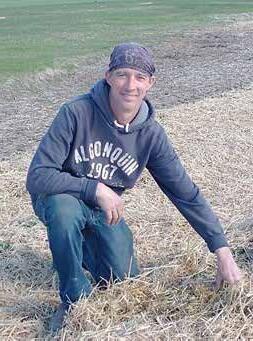
how their farm got its name. The tale includes close-knit families, good food, hard work and lots of happiness about farming.
It begins with their childhoods, in which they both grew up in tobacco farming families of Belgian descent.
Christine’s paternal grandparents, Alphonse and Kathleen Godelie, and her maternal grandparents, Camiel and Alice Bossy, entered tobacco as share-growers before settling on their own farms.
Christine’s parents, Gary and Blanche Godelie, managed a farm near Tillsonburg prior to settling on their own tobacco farm at the corner of the Otterville Road and Highway 59 in 1981.
Similarly, Jason’s parents, Roger and Annie, share-grew on several farms throughout the

tobacco belt, “including one very close to here.”
“That’s what all Belgian and other immigrant families of that time did – they grew tobacco through and through,” said Jason.
Families spent weekends socializing, often through the former Belgian Hall in Delhi, with friendships and marriages uniting families. Jason and Christine met through these tobacco community bonds, marrying in 2004.
Meanwhile, the turbulence affecting the tobacco industry in the early 2000s prompted the Godelies to transition out of tobacco. They pivoted to growing fresh produce, focusing on potatoes and sweet corn. They erected a cabin-like, roadside farm store as part of their marketing.
After graduating from high school in the early 2000s, Jason assisted his family on their farm. With their encouragement, he
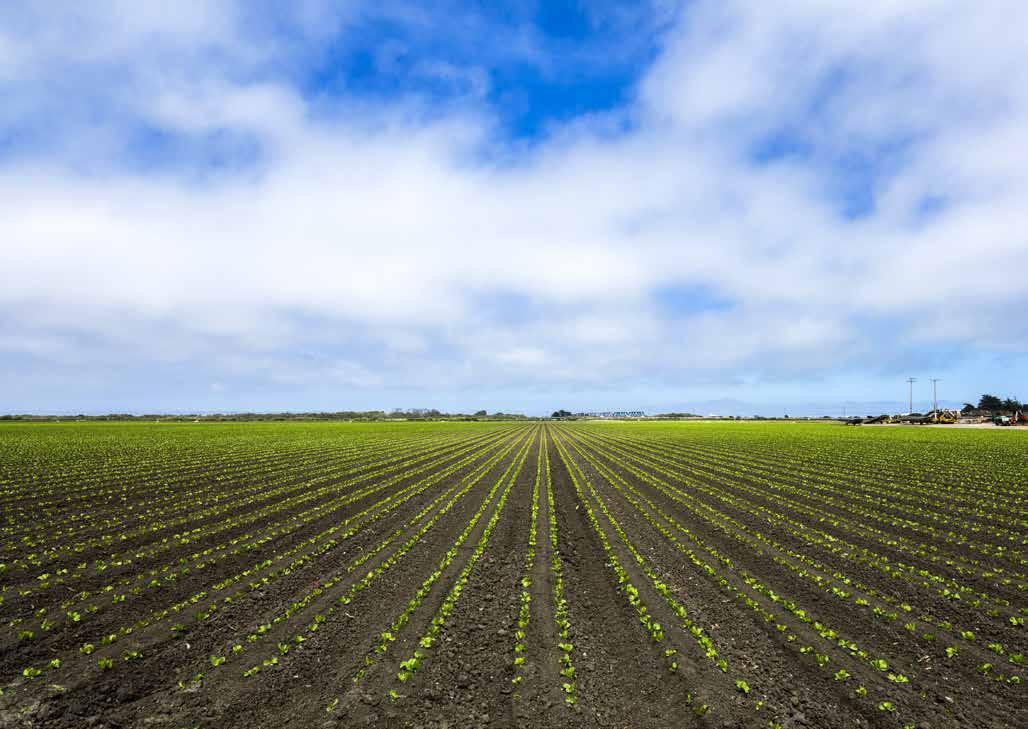




A48 - NORFOLK FARMS - SPRING 2024 COOLING EXPERTS (866) 748-7786 • www.kooljet.com RELIABLE PACKAGED REFRIGERATION
Jason D’Hulster in the strawberry field. The old bulk kilns in the background are now used as storage.
Christine and Jason D’Hulster of Son-in-Law Produce, Otterville.
built a greenhouse from scratch to produce flowers as a sideline. He then managed a ginseng farm near Milldale for 14 years; meanwhile, Christine became a teacher.
But the couple felt the pull of their farm-centred upbringing, pleasures, hard labour and all. Therefore, in 2016, Jason accepted an invitation from Gary to farm as a paid employee. Jason explained that he “wanted to try it for one year in order to get a feel of the operation.” He enjoyed working alongside of his father-in-law so much that they became partners in 2017, as Jason D’Hulster and G & B Godelie Inc.
That’s when he publicly became known as “the son-in-law”.
“When he (Gary) introduced me to customers, he referred to me as his ‘son-in-law’, not by name,” said Jason.
When the Godelies retired around 2020, the D’Hulsters bought the farm. They chose the name, “Son-in-Law Produce” because of Jason’s connection to the Godelies when they took over in 2021.
The D’Hulsters view their farm as a large family garden, just like the ones of their childhood.
“It was a big part of our lives,” said Christine. “Everyone maintained large gardens to feed their families with seasonal, fresh greens. They canned fruit and vegetables and stored root vegetables for winter consumption. If it wasn’t in season, they wouldn’t eat it.”
“Back then, that was what was done to feed the family, not like now with massive farms growing crops,” said Jason. “This
is the key to why we farm – want to produce ‘produce from our garden’.”
It’s a big “garden” on sandy loam with approximately 20 different crops, including potatoes, sweet corn, peas, beans, leeks, peppers, tomatoes, pumpkins, raspberries and strawberries, grown on 380 acres of owned and rented land. They only grow produce, their overall diversity permitting the D’Hulsters to rotate out, although Jason plants rye as a green crop.
“We expanded what Dad did. We love the seasonality of the garden --one crop transitions into another --they flow into each other,”
said Christine. “I keep going back to the image of the garden.”
Jason manages the crops, while Christine, who teaches at a Simcoe secondary school, handles the marketing and paperwork on evenings, weekends and during summer holidays. Their marketing is threefold. They retained the family’s roadside store, which closes in late October; sell wholesale to fresh markets and grocers; and attend five farmers’ markets in the Greater Toronto Area.
Son-in-Law Produce relies upon 21 employees during the heart of the season, including


NORFOLK FARMS - SPRING 2024 - A49
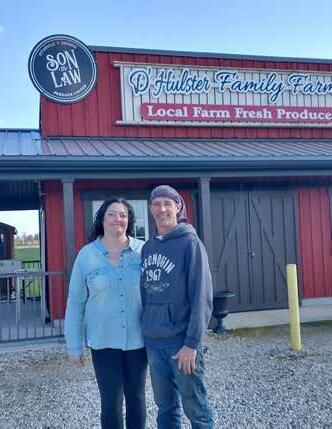
two full time employees, a designated market crew; and especially their veteran Jamaican off-shore workers whom Christina said sometimes actually provide guidance.
“Their (Jamaicans’) expertise is reliable,” said Jason, adding that they remember past problem spots in the fields and report new issues.
The D’Hulsters supplement their product with food produced from local farms, such as honey, maple syrup, asparagus, cider, meat and prepared meals because, said Jason, “We can’t grow it all here.”
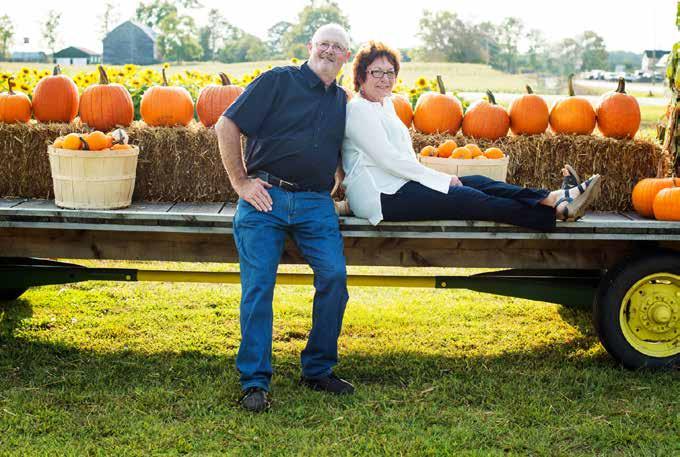
“It supports other growers -- and people like to pick up burgers when they come here for produce,” added Christine.
Family involvement includes Audrey, 16, who shows an interest in retail and the social aspect of marketing, said Christine. Ashton, 13, cuts the lawn, but “wants to transfer into more tractor work.” The Godelie parents help with some marketing, while Roger D’Hulster sometimes assists with the trucking, including the farm’s three vans.
Christine uses her horticultural and agricultural experience to exhibit agrarian opportuni-
to “the
ties to students at a “Green Industries” course she teaches. In one recent class, she brought five different potato varieties from their farm, with plans to teach the youth how to cook mashed potatoes in a subsequent class –which she said delighted those students who love to eat them.
“I do it just to develop an understanding of Ontario agriculture,” said Christine. “If I can just get a couple of students to develop a passion for local food, I’ll be happy. This understanding is what we need.”

A50 - NORFOLK FARMS - SPRING 2024
Son-in-Law Produce retained the former Godelie Family Farm roadside farm store as part of their own marketing strategy. Gary and Blanche Godelie previously owned the farm before selling it
Son-in-Law”.
Crabapples in Norfolk often an overlooked fruit but they are rich in nutrients
Crabapples are Canada’s original apples. The wild species, or Malus coronaria, grows in the Carolinian life zone, including Brant, Norfolk and Lakes Erie and Ontario, providing food and shelter to birds, squirrels, voles, deer, foxes and other species.
The “crab” in crabapple means “small”, just as people sometimes refer to small writing as “crabbed”. Apples are classified as crabs if fruit does not exceed 5 cm in diameter.
Early settlers used the tart-tasting wild fruit to make jelly, cider and vinegar, with some families making it well into the Great Depression.
Tobacco Kilns of Norfolk County
The Delhi Tobacco Museum & Heritage Centre presents the photographs of Larry Monczka in a new exhibit called “Tobacco Kilns of Norfolk County”. Scattered across the region are tobacco kilns, remnants of a once vibrant industry. Through his photographs, Monczka captures the beauty of these gently decaying buildings while documenting the architectural artifacts synonymous with Norfolk’s heritage and history. The aesthetic charm of these iconic structures is balanced with their fragility in images that are both serene and haunting. Join us on May 11 for a poetry reading by Amber Homeniuk. Homeniuk’s poetry recalls the dirty back breaking labour that was the reality of the tobacco industry.
Please visit Larry’s work at www.RaraAvisPhotos.com
Exhibit Opening Reception: Saturday May 11, 2024- 12:30 to 3:30 pm
Exhibit Closes: Saturday October 12, 2024
For more information, please call the Museum at (519) 426-5870 x 8213, check us out on our website at norfolkheritage.ca and or visit us on Facebook and Instagram.

Today, selected modern varieties of crabapples are mainly used as ornamentals which are planted for their beautiful blossoms, which emerge after other apples finish blooming. And their tiny, colourful fruit remain on and around the trees well into the winter.
Crabapple fruit is no longer commercially popular, although a few Norfolk-area orchardists grow a few for niche customers who want to make jelly.
Yet crabapples share the same health benefits as their larger, commercial cousins. They are high in soluble fiber, which can reduce cho-

lesterol level. They are ripe with polyphenols, which are known for their anti-oxidant effects.
Crabapples have abundant pectin – so much so that it’s usually unnecessary to add pectin in jelly making. Because pectin is a prebiotic, it assists in maintaining good intestinal health. Apples also contain quercetin, which assists in reducing inflammation and regulating the immune system.
While crabapples are traditionally associated with jelly, they can be used to make the same dishes as larger apples – applesauce, crisp, juice, liqueur and apple butter.



NORFOLK FARMS - SPRING 2024 - A51
i2i
SOFTWARE FOR AGRICULTURE Complete ERP So ware for Growers, Packers, and Distributors. Modular, Scalable, and Fully Customizable Labour Tracking Product Traceability Inventory Management Sales and Purchasing Harvest Tracking SKU Costing Crop Costing Food Safety Asset Management Facility Management IPM Supplies Inventory Visit i2iautomation.com for a free demo! Contact us at enquiries@i2iautomation.com Farms, Greenhouses, Packhouses, Vineyards, Orchards, Nurseries Developedby forfarmers, Farmers!
Automation
VISIT OUR WEBSITE AT WWW.NORFOLKFARMSNEWS.CA
Selective breeding played huge role in crops
In this world where people talk a lot about heirloom varieties and genetically modified organisms in regard to grains, there is an assumption that the fruits and vegetables we consume haven’t had a lot of tampering in their past. This is not so.
In fact, the list of fruits and vegetables that could be called “man-made” is quite extensive, even amongst the crops grown in Norfolk County. It includes, corn, watermelon, apples, broccoli, cucumbers and many more. In fact, it’s so vast most people would be surprised.
Broccoli is a perfect example of early cross-breeding, and is responsible for many more vegetables. Broccoli has been around for centuries, and is a descendant of the wild mustard plant Brassica oleracea. The earliest broccoli was much smaller and more bitter. Wild mustard was only present in some parts of the Europe and Mediterranean 2,500 years ago. Taste varied dependent on where the plants grew. Greek and Roman farmers first tinkered
with wild mustard plants with larger leaves to develop kale and collard greens. A succession of other plants followed, including broccoli, cabbage, Brussel sprouts, cauliflower and kohlrabi.
Carrots are another that most would never think came from early breeding. Although there are accounts that carrots were eaten by Romans at the time of the Roman Empire, researchers believe these may have been parsnips. Early carrots were likely white or purple. Today’s orange carrot is a hybrid of the yellow carrot, which in turn was hybridized from the white carrot.
Iceberg lettuce, which is one of the most common vegetables, is a more recent hybrid. Atlee Burpee and Co., a mail-order seed company, was working in the late 1800s on developing vegetable varieties that worked better for commercial farming and shipping. Burpee introduced head lettuce in 1894, claiming that it retained its freshness and crispness better. Farmer Bruce Church took this one step further
in the 1920s, and started shipping head lettuce packed in ice to keep it fresh. This resulted in the term iceberg lettuce.
Like many varieties, cucumbers were originally bitter. At the time of the ancient Romans and Greeks, cucumbers needed to be cooked to be consumed. By Victorian times, cucumbers had been cultivated to the point that they could be eaten raw as we do today.
The trend of hybridization also continues with fruits. Tomatoes, which are a fruit, are believed to have originated from a wild tomato in South America that was domesticated 7,000 years ago. The wild plant had a tiny fruit and ancient South Americans hybridized it to the size of a tomato. Early tomatoes didn’t reach Europe until the 16th century.
THINK FAST. AND HOT.




Corn has its roots, or at least part of them, in North America, but is still a hybrid. Indigenous groups in Mesoamerica, which covers southern North America, Central America and parts of northern South America, started with a wild grass called teosinte. These plants had smaller cobs with only a few kernels. Selective breeding by Indigenous people resulted in the early corn plants found when Europeans first came to the New World. That early corn has been refined in the centuries since.
Watermelons underwent one of the largest size transformations through selective breeding since the time of the ancient Egyptians. The watermelon’s predecessor was only two inches across and bitter. Thousands of years of selective breeding resulted in the melons we have today.
Apples are one fruit with numerous varieties that are well known, and newer varieties have been produced in recent decades. It’s not surprise that there has been some human tampering from the modern apple’s predecessor. The apple originated in central Asia, was sour and inedible. Time and crossbreeding have changed that.
Surely, strawberries must be safe as wild strawberries grow in Ontario? Wrong again! Any assumption that the berries we have today are just a larger berry that grew elsewhere are incorrect. The French started cultivating the wild strawberries that grew there in the 1300s and managed to increase the size. It took until 1764 when Antoine Nicolas Duchesne realized there are male and female strawberries before the fruits reached near the size they are today.
And the list goes on beyond the crops planted in Norfolk County. Oranges, grapefruit, peanuts, bananas, and almonds have all had human influence to reach the products of today.

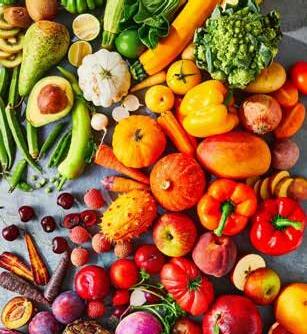
A52 - NORFOLK FARMS - SPRING 2024
Always read and follow label directions. AgSolutions and IGNITE are registered trademarks of BASF, used under license by BASF Canada Inc. © 2024 BASF Canada Inc. Efficient and complete burndown of annual grasses and broadleaf weeds. When it comes to controlling weeds, you don’t have time to mess around. That’s why there’s Ignite® herbicide. It provides proven and complete burndown of annual grasses and broadleaf weeds within 7 to 10 days in a range of crops, including tree fruit, blueberries and grapes. And as an additional bonus, Ignite also prevents sucker growth. So what are you waiting for? Visit agsolutions.ca/horticulture today.
Publication: Norfolk Farms Page Position: 1/2Island4C DARIN V1 KEN Client: BASF HORT File Name: IGNITE_2024_Print_NF_v1 MAG 3217_2_IGNITE_2024_Print_NF_v1.indd 1 2024-01-05 2:58 PM
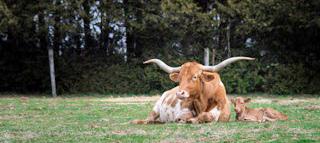
Continued from page A23
tally we are building value for the farmers of Canada. That means we (farmers) are part of conversations we haven’t been part of for a long time. Farmers realize they are part of the solution to a lot of things, like climate change mitigation, biodiversity, species-at-risk and flood control.”
Fruit and vegetable growers adopting sustainability practices, study finds
One of the offshoots of Norfolk’s initial efforts occurred after Prince Edward Island environment George Webster attended the pilot launch in 2008. The island was having an environmental issue at the time and ALUS quickly became the solution and a well-funded provincial program.
plications are only applied as needed. Four out of five use soil test results to be more precise with fertilizer application. Nearly as many, 78 per cent, use cover crops.
Bryan
They’ve also been growing their sustainability practices.
On Earth Day, the Ontario Fruit and Vegetable Growers’ Association released a study conducted with the help of the Vineland Research and Innovation Centre that showed a strong move over the past two decades towards sustainable practices by a large swath of Ontario’s fruit and vegetable growers.
“This study shows very clearly that Ontario’s fruit and vegetable growers are prioritizing sustainable production and have voluntarily been making major strides in the last two decades to adopt practices that support both environmental and economic sustainability,” said Shawn Brenn, a vegeta ble grower and chair of the Ontario Fruit and Vegetable Growers’ Association (OFVGA), in a news release. “We’re a proud part of On tario’s food system and we want Ontarians to know that we’re doing our part to ensure a greener future for all of us.”
- Growers adopt sustainable practices for these top reasons: cost savings, a desire to be
Cathy raise Texas longhorns on the YU Ranch, south of Tillsonburg.
We Know Norfolk

(519) 718-3384
Highlights from the study include the fol lowing:
Broker of Record
- Water efficient irrigation systems, insula tion for energy efficiency and biological pest control systems are used by 95 per cent of respondents in the greenhouse sector. Two thirds said they installed more efficient boilers, climate control and irrigation systems over the last 20 years, along with heat storage and energy curtains.
Dean Morrison (519) (519) 909 - 0340
Dean Morrison (519) 909-0340

Matt Devos

- For outdoor growers, 85 per cent said they’re using crop scouting and pest monitoring to target crop protection so that ap-
Today, nationally ALUS is approaching 1,000 farmers participating through 27 different community based programs in six provinces. Together they have enrolled 27,183 acres in the program.
ment, a minimal margin to adopt practices due to high operating costs, and a lack of time and capacity to experiment with new practices and technologies. For greenhouse operators, an
Officially, ALUS Canada’s mantra now is: “ALUS Canada makes it


FORTIFY YOUR CROPS WEAKEN THEIR FOES






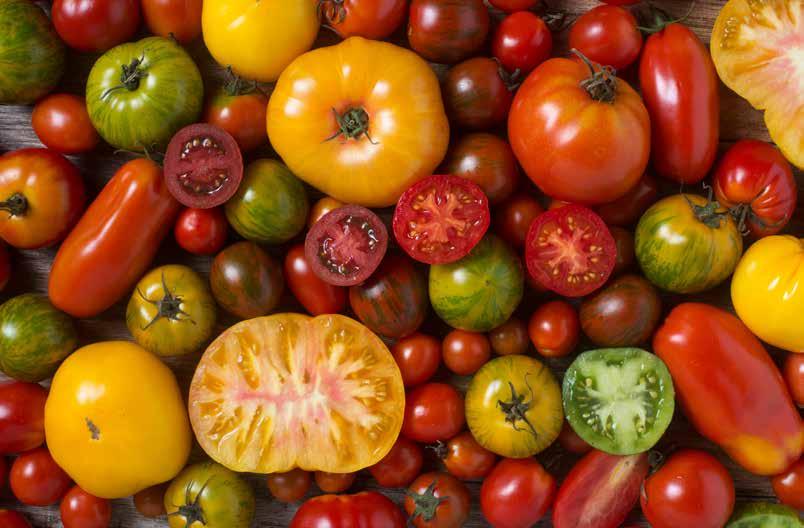



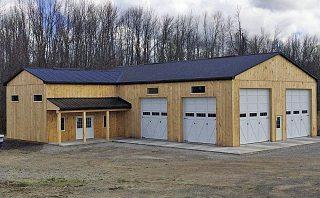
NORFOLK FARMS - SPRING 2024 - A53
1-800-215-1996 Quality Since 1979
Dean Morrison (519)
For buying and selling farms, call... (519)
909-0340
909-0340
909-0340
Gilvesy, now CEO of ALUS Canada, started his involvement with the program when he signed up as a participant to the program and then became a member of the Norfolk Partnership Advisory Committee. Bryan and wife
GROUP 50 FUNGICIDE Orthosilicic Acid Silicone Turn to page B22
Industrial compostable biopolymer for greenhouse twines
BASF expands its offering for sustainable food production: Its certified compostable biopolymer ecovio® can now also be used to manufacture black twines used to grow annual fruit and vegetables in commercial greenhouses.
The grade ecovio® T 2206 is certified industrial compostable according to EN13432. This means that after harvesting the twines can be collected together with the plant residues and transported to industrial composting facilities (depending on local regulations) where they biodegrade.
With this new end-of-life option for twines, persistent microplastics in organic waste can be avoided while at the same time more green waste can be turned into valuable compost. The industrial compostable ecovio® thus supports organic recycling and helps to close the nutrient loop to achieve a circular economy.
Twines made of ecovio® T 2206 can be used to help creepers like tomatoes and cucumbers to climb upwards in greenhouse structures in many climates from Europe, South America to Asia and Canada: Tests show the twines’ excellent performance until the end of the crop cycle.
After harvesting farmers do not have to laboriously separate the twines from the plants but simply collect them together for composting. The certified industrial compostable twines do not only show benefits for farmers but also for manufacturers: ecovio® T 2206 can be produced on standard polypropylene (PP) machinery for twines.
From B21
More BASF biopolymers for agricultural applications
BASF’s biopolymers portfolio for sustainable agriculture and food production also includes the certified soil-biodegradable grade ecovio® M 2351 (according to EN 17033). It was especially developed for mulch films used in agriculture and horticulture to increase the yield, speed up harvesting as well as to save water and herbicides.
Mulch films made of ecovio® M 2351 are completely and biologically degraded by microorganisms like bacteria and fungi that exist naturally in the soil.
Farmers can simply plough the mulch films made of ecovio® M 2351 back into the ground after harvest. This saves time and money - and it helps to avoid persistent microplastics in agricultural soil which would occur, if farmers used conventional mulch films made of non-biodegradable polyethylene (PE).
BASF’s biopolymers enable organics recycling
BASF’s biopolymer ecovio® is certified compostable in accordance with standards such as EN13432. It is a blend of BASF’s PBAT ecoflex® and renewable raw materials. Typical applications for ecovio® are organic waste bags, cling film, fruit and vegetable bags, as well as agricultural mulch films and food packaging applications. Studies show the advantages of ecovio® for production, packaging and shelf life of food as well as for the collection of food waste.
These advantages are based on the material’s certified biode gradability in industrial and home composting as well as in agricul
and 78 per cent of outdoor operators saying they do. The Environmental Farm Plan is the most popular.
Generally speaking, it found growers are willing to make continued changes. Respondents said addressing larger issues regarding competitiveness, taxation, red tape and regulatory burdens will make it easier for them to transition to more sustainable practices. Incentive programs would also help, the study found.
“We’ve made tremendous progress in the last two decades, and growers are willing to do more, but farms need to also be financially viable, which includes a streamlined regulatory environment, financial investments and the consumer support,” said greenhouse grower Jan VanderHout, chair of the OFVGA Environment and Conservation committee. “Fruit and vegetable production is an essential pillar of our local food system and it’s critical to Canada’s national security that we do everything we can to preserve and protect our ability to grow healthy, safe and sustainable produce.”
tural soil: Food waste is reduced, nutrients are returned to the soil by means of greater volumes of compost – and the accumulation of persistent microplastics in agricultural soil is avoided. This by closing the nutrient cycle via organics recycling.
Further information: www. ecovio.basf.com and www.biopolymers.basf.com









FOES



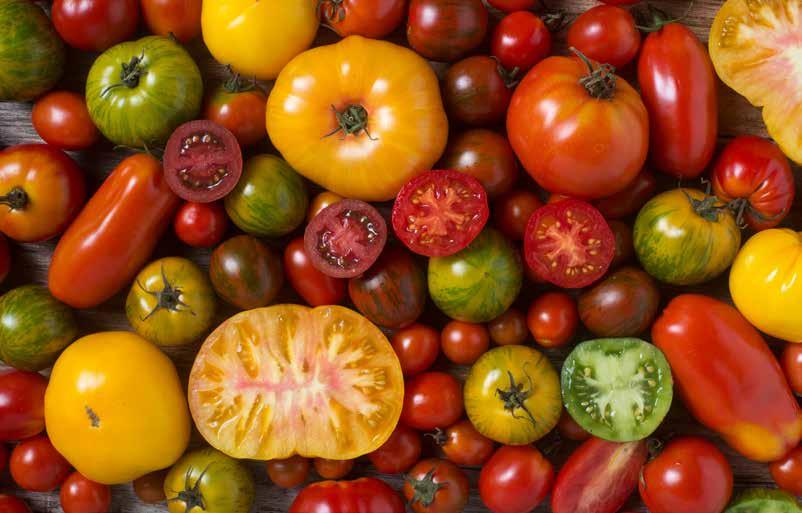

A54 - NORFOLK FARMS - SPRING 2024
YOUR
THEIR
GROUP BM 02 FUNGICIDE/ BACTERICIDE
FORTIFY
CROPS WEAKEN
(1) 5,000 sq ft unit & (1) 1,000 sq ft unit Overhead door & loading dock Backup diesel generator Call (519) 521-4010 | Email geoff@execulink com Location: 245715 Milldale Road, Otterville Ventilation walls (5 000 sq ft unit only) Temperature: 2° Celcius
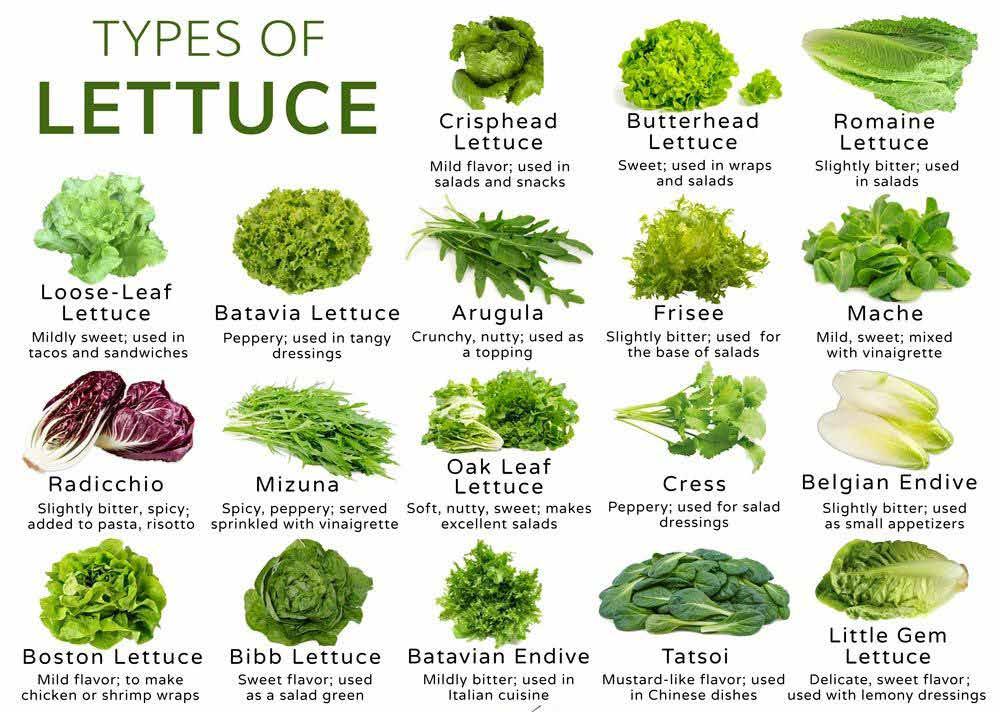
Manessa- new A hybrid green cabbage for the fresh box market. It is stable under stressful conditions and uniform under different planting densities. Matures in 65 to 70 days. Ideal spring and summer plantings.



Regulator F1
Attractive and widely adaptable variety. Puts out a high rate of 4 lobbed fruit with consistent sizing throughout the growing season. The plant is strong with good leaf cover and good disease package.
Spritz- new Superior eating quality, good ear size. Excellent field holding ability with rust protection. Glossy, full kernels. Very sweet tasting ear and crunchy kernels.



Bringing

Jeremy Schotsman
NORFOLK FARMS - SPRING 2024 - A55 A division of AgrocentreFertibecInc 20 rue de l’Industrie, Saint-Rémi, QC J0L 2L0 TOLL FREE: 1-877-337-8423
Ontario Sales Representative Cell: 705 434-7292 Jeremy.schotsman@agrofertibec.com
innovation
expertise.
you the best Vegetable Seed, backed by
and











March
-
TAKE ADVANTAGE OF 2013 Challenger MT 665D, 250 PTO HP 290 Engine HP, 8.4L Sisu, Deluxe Cab, Auto Climate Control, 4WD ....$185,000 2011 Fendt 822, 5,350 Hours, Estimates 240 Hp Eng, / 200 pto, Deutz 6.1l 6 Cyl, 4 WD, Pneumatic Cab Suspension ....$149,000 2Bale processor P210GT-M, 2014 model, Electric/hyrdaulic Controls, 540 RPM,Dual Drum....$18,900 2014 New Holland Telehandler, 2230 Hrs, NEF 4.5L 120HP, Air seat, Hydraulic quick attach $119,500 Bobcat V417 Telehandler, 1793 hours, Kubota 75HP, Heat/AC, Mechanical Seat, 2 Speed-left hand shuttle....$76,000 2022 Merlo TF33.7 Telehandler, 2376 Hours, Deutz 115HP Engine, Has Heat/AC, Air Seat, 2 Speed, ...$118,900 Dion F41 Pull type Harvester, 12 knife cutterhead, Kernel Processor, metal alert, Stinger Spout (Camera Ready) Rear Hitch ...$74, 900 H&S V RAKE -BF12HC, 2014 model, Pull Type, 12 Wheel Hi Capacity Bi-Fold ... $14,000 2003 JD 7810, IVT, Front Suspension, Front Hitch and PTO, Integrated Guidance, 7830 Hours, Super Clean $CALL MF TD1310 Tedder, very little acres, 10 rotor 41'8" width, drawbar hitch, 540 PTO. ......$37,000 10" X 70' Grain Auger 205-7515 Tires, 5 Bolt Back Saver 540 PTO Drive Scissor Lift ....$6,900 BOOTH # 724 B 1.99% Financing For 60 Months!! STRAIGHT FORWARD & DEPENDABLE MF 7s Series Tractors. 2021 Fendt 724 G6, 1300 Hrs, 195 PTO/237 ENG, 6.06L, Super Comfort Seat, Auto Climate ....$329,000 2022 AFS Connect Magnum 380 Row Trac,700 Hours,30” rear tracks, Front suspension, Fully Loaded....$CALL 2021 Fendt 724 G6, Profi Plus, 750 Hours, CVT, 5 remotes, front hitch/PTO, LED lighting, loaded ....$330,000 519-688-0605 office@deysequipment.com 185022 Cornell Rd, Tillsonburg ON Used Equipment: 2022 Fendt 313 power version, 1500 Hours, 130ENG/100 PTO, 4.4L Agco Power 4-cyl, 40km CVT ....$179,000 2014 Kinze 4900, 24 row 30” central fill planter, unit mounted coulters, Aulari Dry Fertilizer with scale,....$175,000 John Deere 1745 – 2022 Model, 8/15 corn/ bean planter, dry fertilizer, fertilizer cross auger, $139,900.00 White 9824-2013 24RN, Montag 9 ton dry fert, Aulari openers, pneumatic DP, 300 Gal liquid, loaded! $195,000.00
6th
8th














































































































































































































































































 Diamond Mine is one of the best tasting whites available.
sweet corn that produces large ears with excellent tip fill and husk cover.
Diamond Mine is one of the best tasting whites available.
sweet corn that produces large ears with excellent tip fill and husk cover.










































































